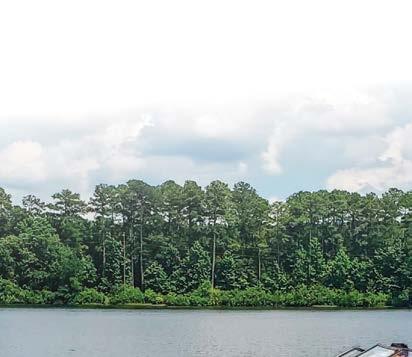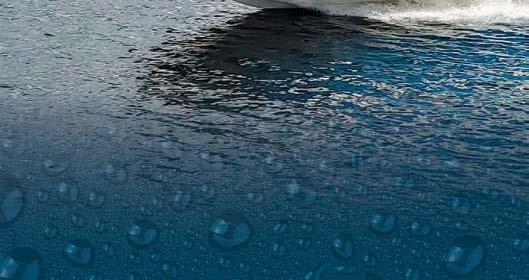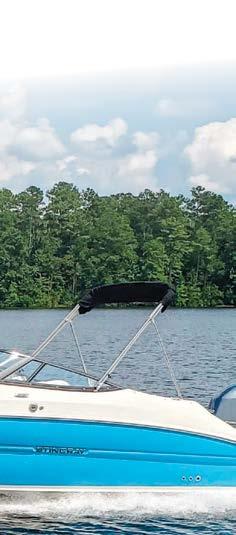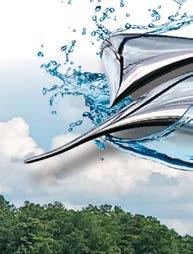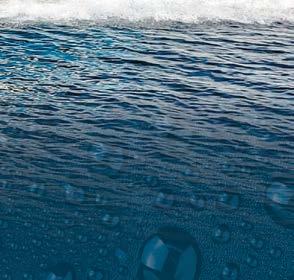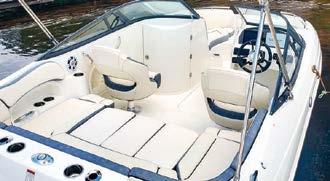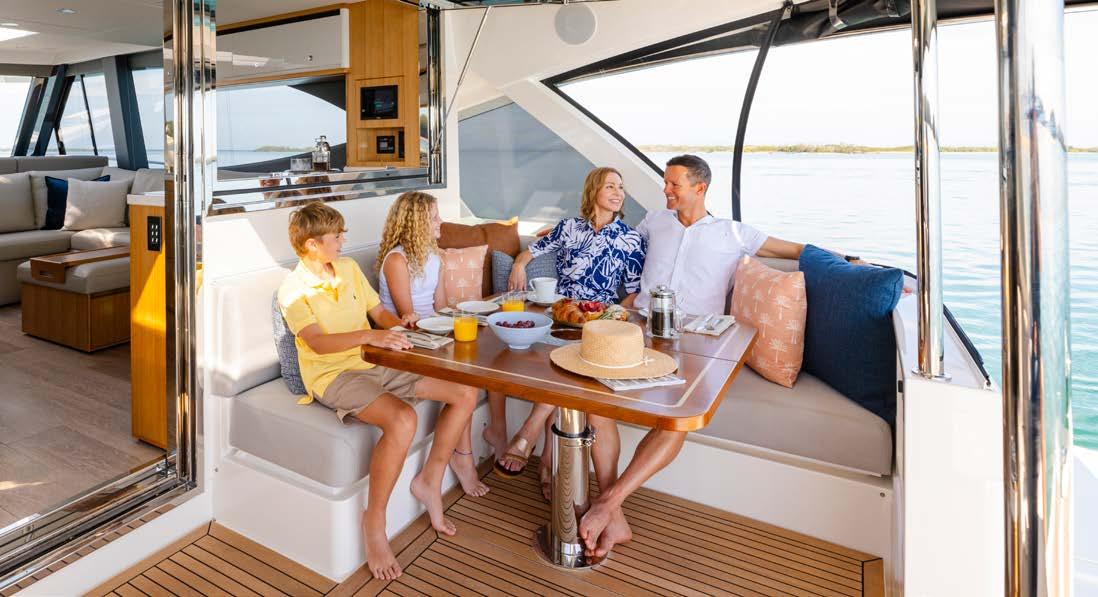












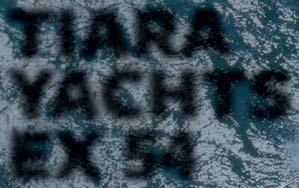
Personalize your ride.






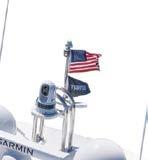



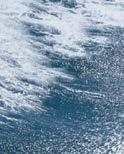
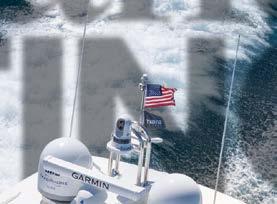

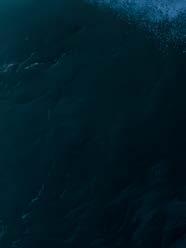




REGAL 38 SURF
A multi-purpose surfing machine.
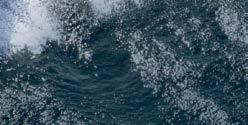
The U.S. Power Squadrons looks to the future with a fresh rebranding.
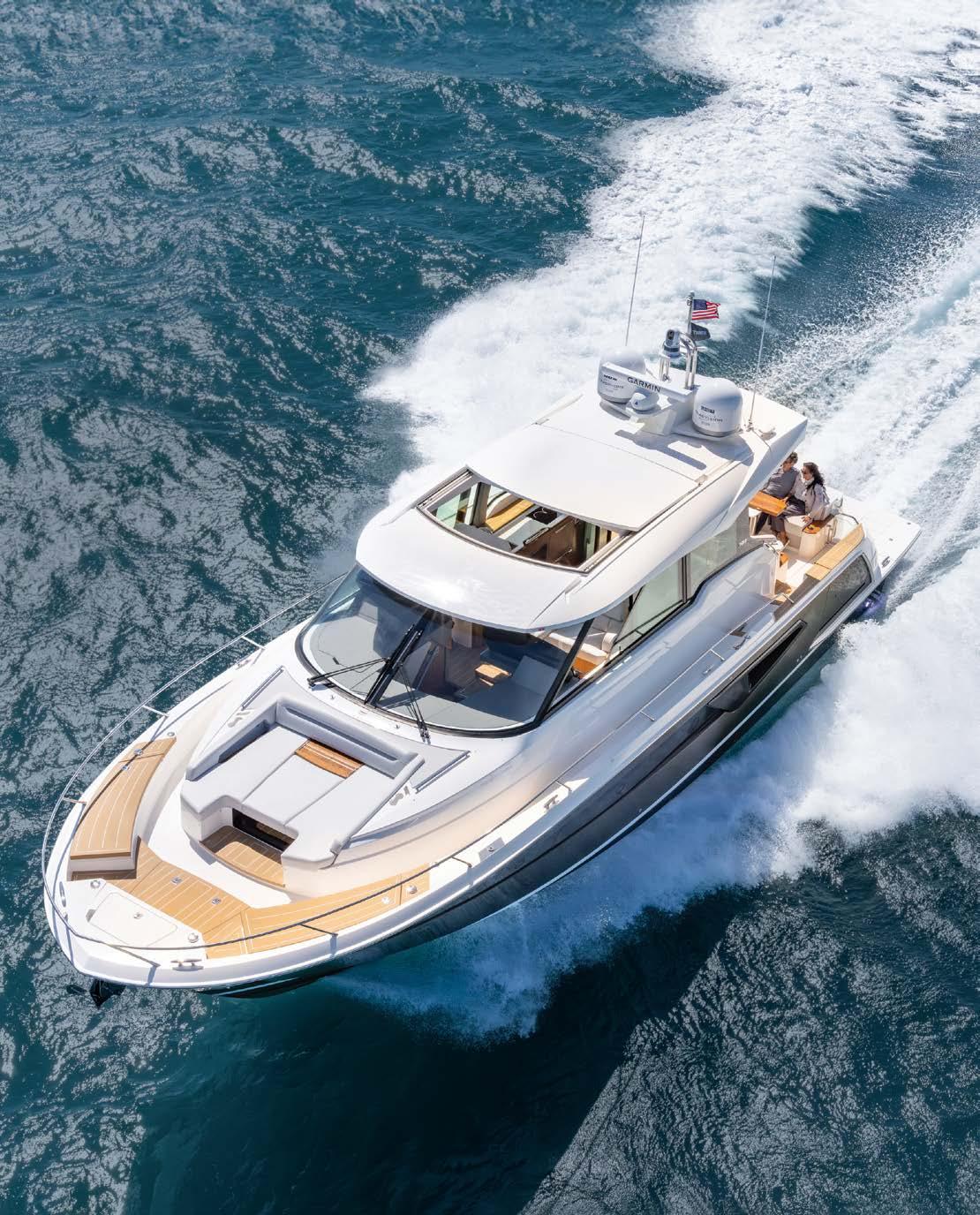


Tobermory, ON: A nature lover's paradise at the tip of the Bruce Peninsula.

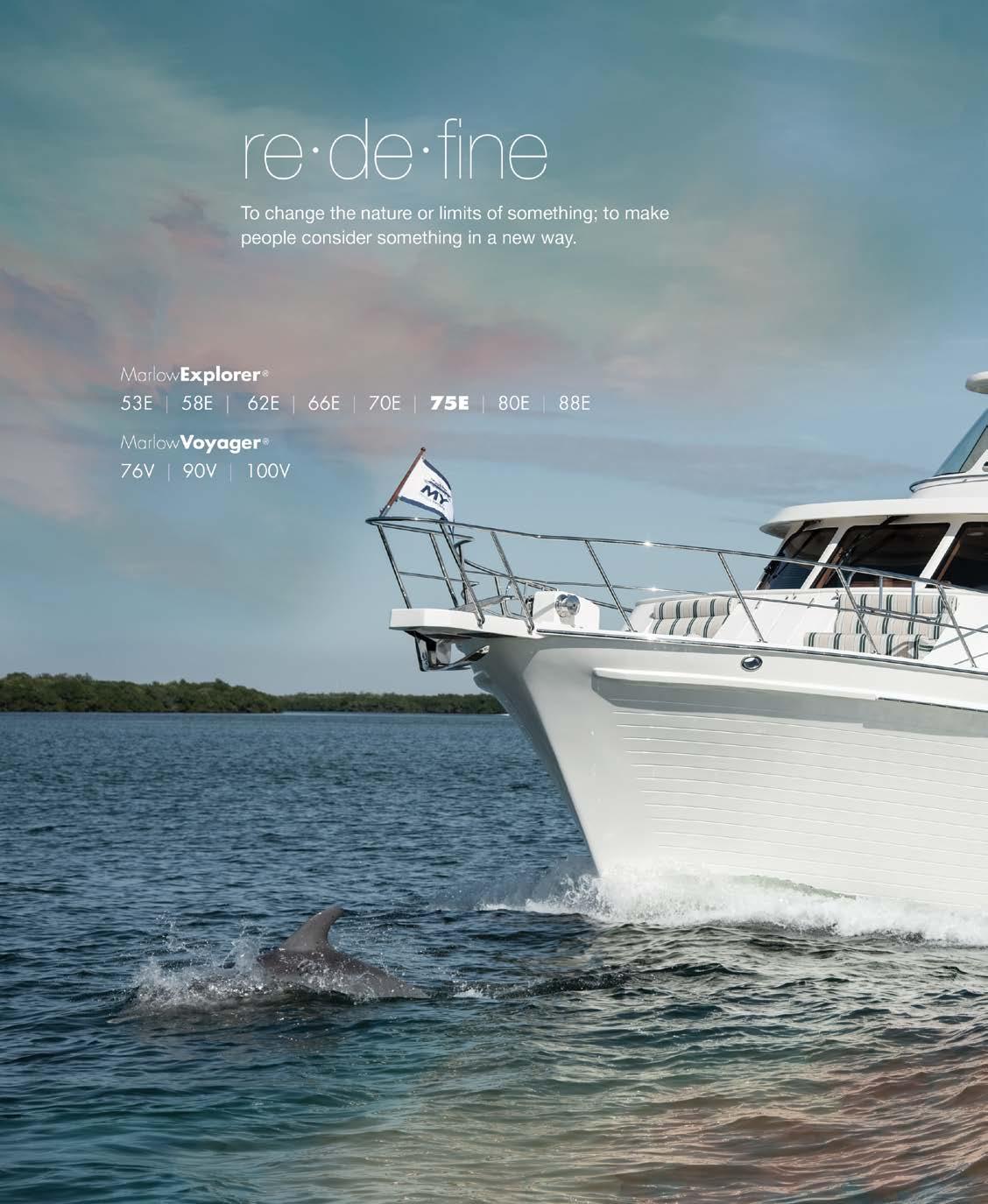
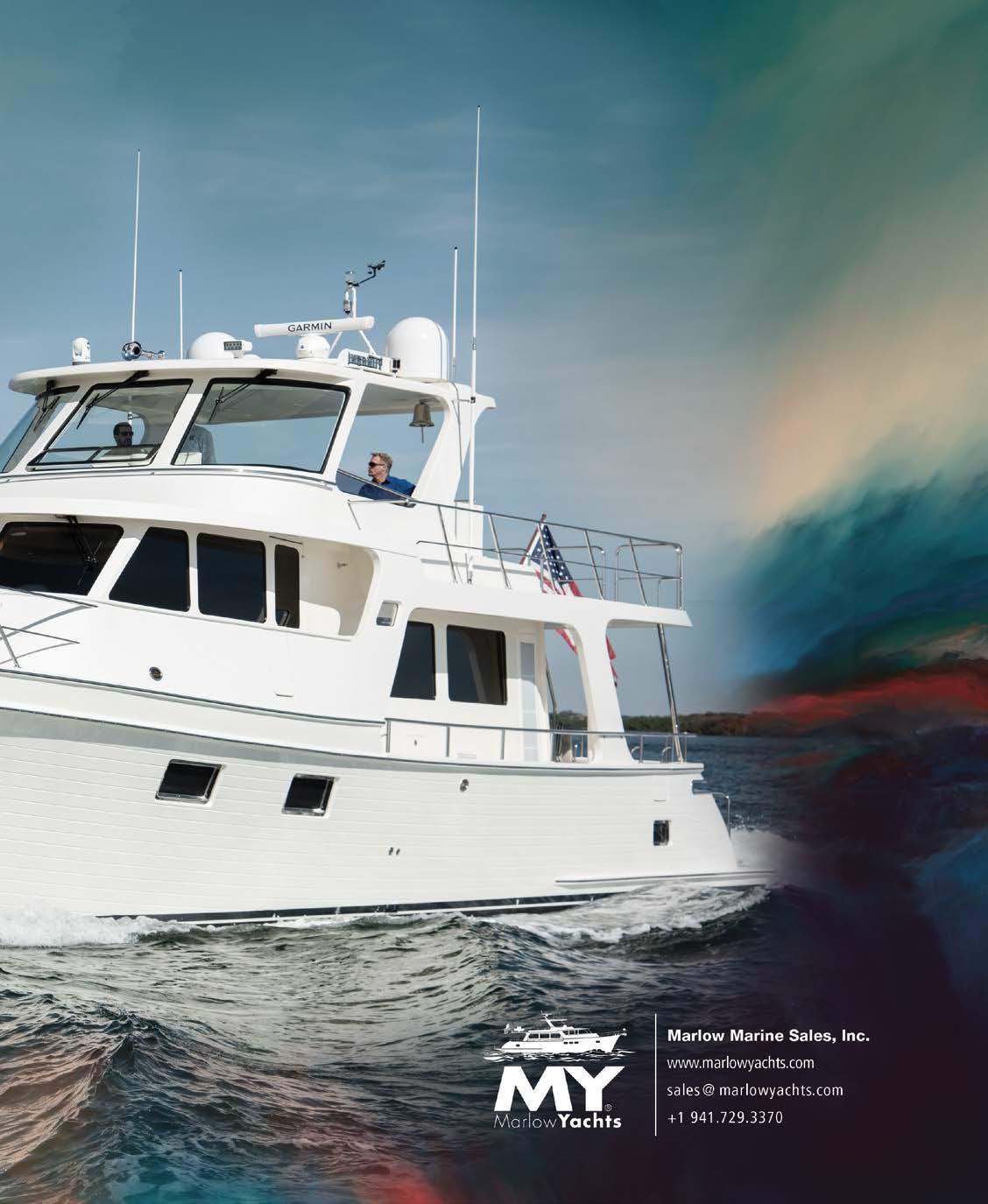

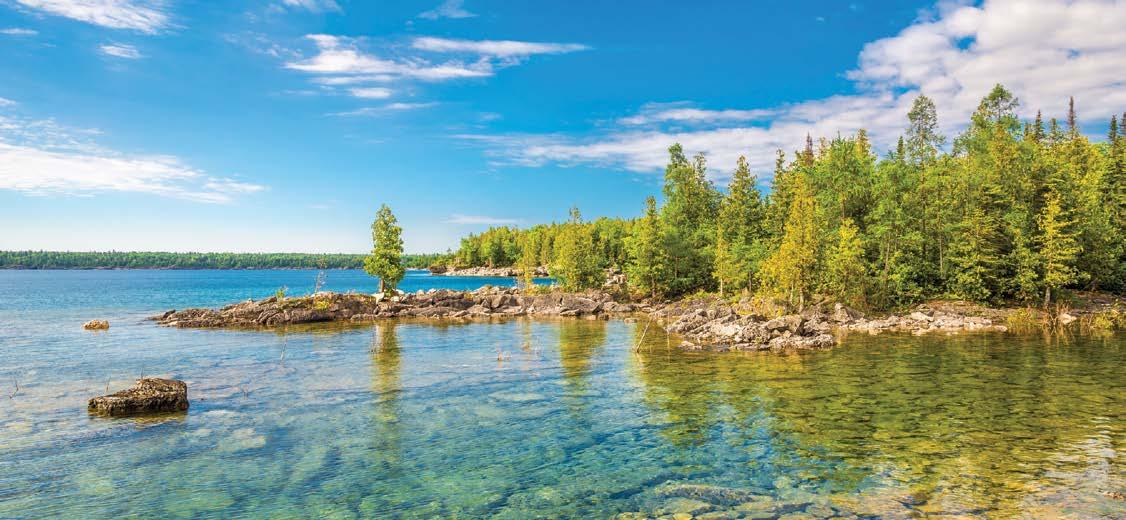
28 Tiara Yachts EX 54
Peerless reputation and all you would expect from Tiara. By
Peter Frederiksen32 Regal 38 Surf Surf’s up. By Kevin Koenig
36 America’s Boating Club: Safety First
Updated name, same core mission, as United States Power Squadrons looks to grow.
By Kathy Gibbons40 Port of Call: Tobermory, ON
Where the World Begins: Perched at the tip of Ontario’s Bruce Peninsula, Tobermory might signal the end of the road for motorists, but for boaters, it’s where the land ends and the whole world begins.
By Craig Ritchie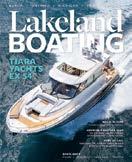

Tiara Yacht’s brandnew EX 54 packs a lot in 54 feet, namely three cabins (so there’s plenty of space to invite your friends for a weekend away), three clever cockpit modules (depending on your preferred type of boating), hullside terraces (to expand the deck) and so much more!


Stay current on all the latest Great Lakes news Peruse dozens of exciting destination stories Check out our latest Boat Tests & Spotlights Place a classified ad Shop boats for sale by owner Purchase our Great Lakes Cruising Guides and Lakeland Boating hats Access past issues with our online magazine Sign up for our weekly e-newsletter and more!
From the Helm 6
Dock Box 8
Calendar 10
Scuttle 12
Great Gear 17
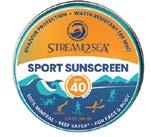
Tech Deck 20
Classic Craft 64 ON THE COVER
Don’t Hesitate to Renovate 18
Safety First 21
Beneath the Surface 22
Boat Spotlights: Crevalle, Grady-White, Lancia Aprea, World Cat 24
Lakeshore Life: Spring Lake, MI 46
Marina Watch: B&E Marine 48
Marine Marketplace 50
Classifieds 63
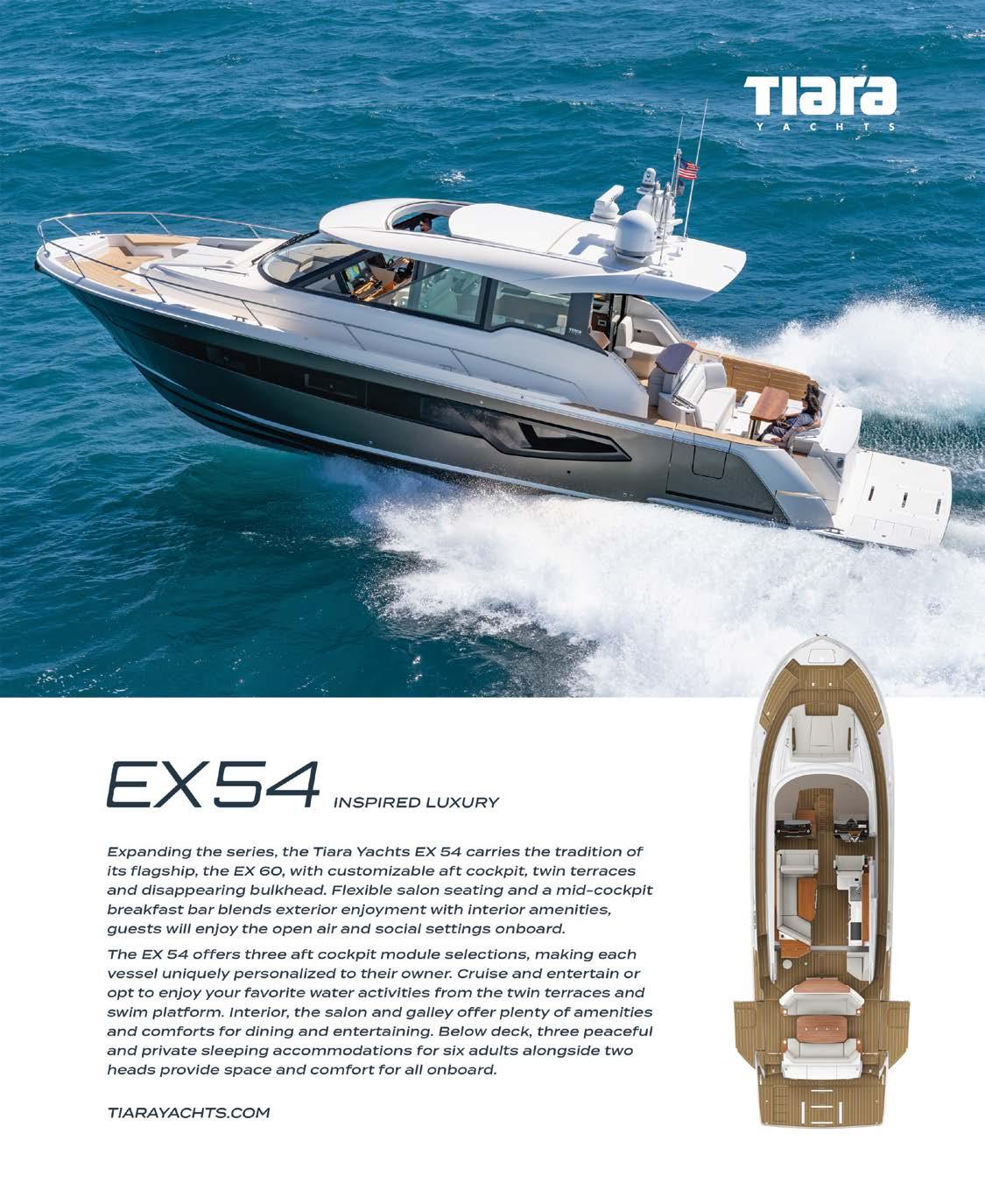

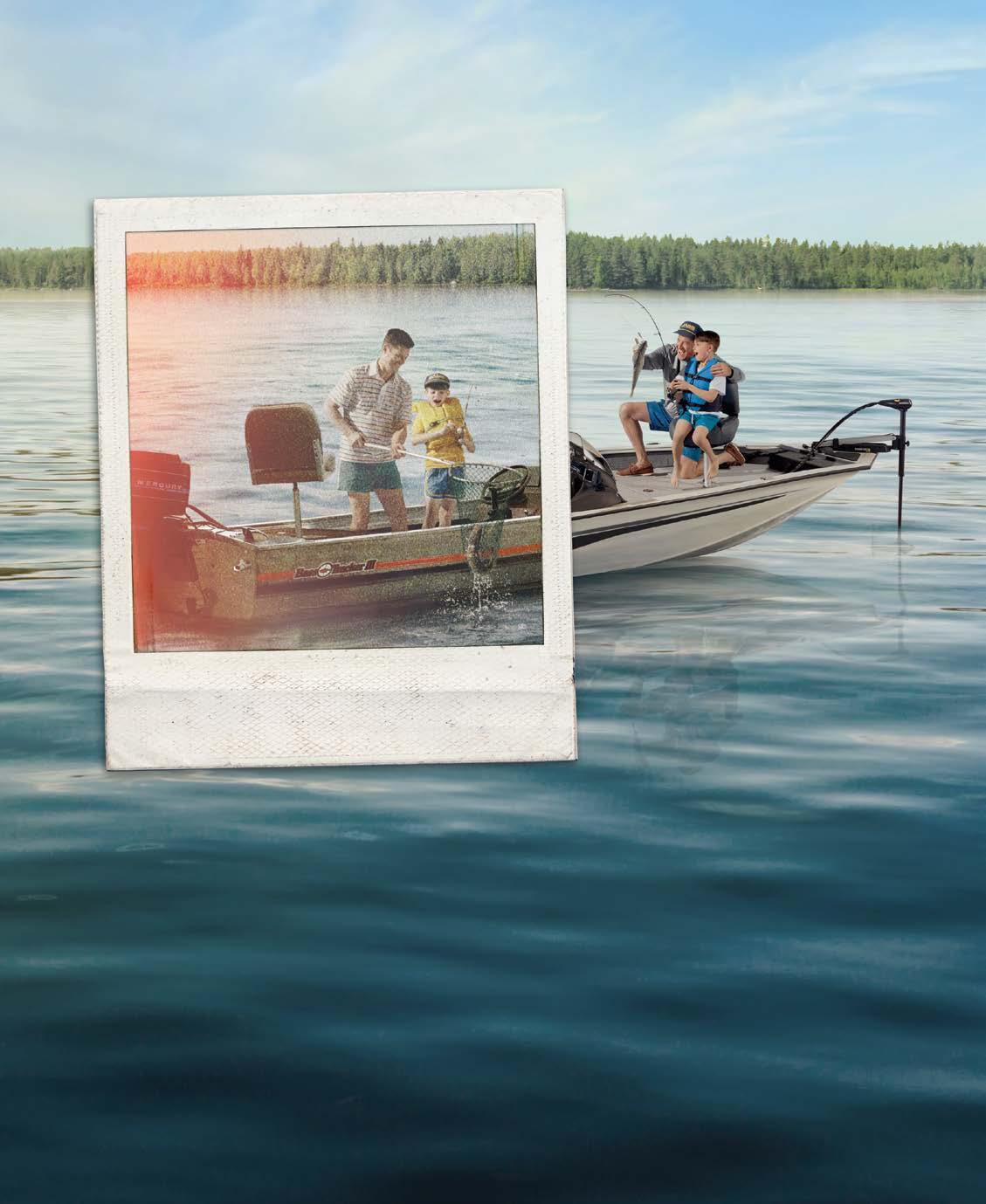

May 18 – 24 marks National Safe Boating Week. To prepare for the upcoming boating season, the National Safe Boating Council has seven tips to remember, including: Never boat under the influence; watch the weather; make a float plan; and use an engine cut-off switch.
The council’s No. 3 suggestion is to carry all required safe boating gear onboard. To help you out in that regard, flip over to our Great Gear department for everything from life jackets to carbon monoxide monitors (p. 17).

The No. 2 boating tip is to take a boating safety course. In this month’s Beneath the Surface column, Heather discusses the benefits of introducing boating education early, helping instill safe practices at a young age (p. 22)! We also take a look at the U.S. Power Squadron’s rebrand into the America’s Boating Club (p. 36). This wonderful organization offers everything from boating education to free Vessel Safety Checks and so much more.
Last but certainly not least, the No. 1 tip is to always wear a life jacket onboard!
Use all seven safety tips to cruise over to the stunning landscape of Tobermory, Ontario (p. 40). Here, at the top of the Bruce Peninsula, you’ll find crystal clear water, two national parks, shipwrecks visible from shore and the picturesque Niagara Escarpment. There is so much to explore at the “end of the road.”
Safe boating!

Do you have a story idea you’d like to suggest? Email me at kbush@lakelandboating.com to share your ideas.

KEN KREISLER
A multi BWI awardwinning journalist, Capt. Ken began his nautical career while in high school, spending summers doing odd jobs in the boatyard of a local marina in Brooklyn, New York. He worked his way through undergraduate, graduate and postgraduate academic studies as the skipper of his own six-pack charter boat, and upon completion of his degree work, secured his first job as a writer in the marine industry and never looked back. Capt. Ken splits his seasonal time between the New Jersey Shore and West Palm Beach, Florida.
HIS STORIES START ON P. 24
PETER FREDERIKSEN
An award-winning editor and marine journalist, and a 100ton Master Mariner, Peter’s helm experience ranges from Gloucester, Massachusetts, to the Bahamas, south to Mexico and west to Baja and Alaska.

READ HIS STORY ON P. 28

KEVIN KOENIG
Kevin is an awardwinning journalist living and working in Greenwich, Connecticut. His 14 years in the marine industry have helped him live a fulfilling and adventureladen life thus far.
READ HIS STORY ON P. 32
KATHY GIBBONS
Kathy is a freelance writer and editor based in Traverse City, Michigan. She spent about 25 years as a features editor at the Traverse City RecordEagle before working as managing editor of custom publications for Hour Media in metro Detroit. She currently edits Michigan Meetings + Events magazine and freelance writes on a variety of topics.

READ HER STORY ON P. 36
Whatever
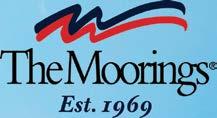



Gryphon
I named my boat Gryphon after Le Griffon, the first ship to explore Lake St. Clair. Built in 1679 upstream from Niagara Falls, it was captained by Franciscan priest Father Hennepin and cartographer and French explorer Rene-Robert Cavalier, Sieur de La Salle. Lake St. Clair was named after St. Clair of Assisi, as Le Griffon traversed the lake on her feast day, August 11.
—JoeWhelan, St. Clair Shores, MI
Name Game: We’re always on the lookout for clever and interesting boat names! Send us a short write-up about why you chose your boat name, along with your name, your home city and state, and a high-res photo of your boat (at least 1 MB). Send to KBUSH@LAKELANDBOATING.COM and put “Name Game” in the subject line.
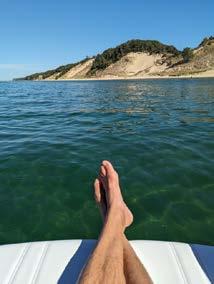

Calling All Canine (and Feline) Crew!
We want to learn about your furry friends onboard! Send a short write-up with your pet’s name and your home city, as well as a high-resolution photo (at least 1 MB) to: KBUSH@ LAKELANDBOATING.COM.
Please put “Canine/ Feline Crew” in the subject line. If we publish your submission, you’ll win a Lakeland Boating hat!
Lake Lens
Taken sitting on the back of our Regal 35 Sport Coupe on an unseasonably warm day in early October 2023 just south of Holland, Michigan. Clear water, blue sky, beautiful dunes — and my feet loved the sunshine!
—Daryl Morrical
Lake Lens: We want to see the gorgeous Great Lakes from your point of view! Send a high-resolution photo (at least 1 MB) and a short write-up about that photo to KBUSH@ LAKELANDBOATING.COM. Please put “Lake Lens” in the subject line. If we publish your submission, you’ll win a Lakeland Boating hat!



Great in a Lakeland Boating Hat!

Need a gift for your favorite boater? Our Lakeland Boating hat is constructed from soft cotton twill for a great fit. Leather band adjustment in back with antiqued brass closure. Available in weathered navy or Nantucket red (khaki sold out). One size. $24.95 + S&H. To order, visit LAKELANDBOATING.COM/STORE.
� WE WANT TO HEAR FROM YOU!
Email us at KBUSH@ LAKELANDBOATING.COM or drop us a line at Lakeland Boating, 1555 Sherman Ave., Evanston, IL 60201. Opinions expressed in “Dock Box” are not necessarily those of the Lakeland Boating. Letters may be edited for length and clarity.
MAY 2024
VOLUME LXXVIII, NO. 5
PUBLISHER
Linda O’Meara
PUBLISHER IN MEMORIUM
Walter “Bing” O’Meara
EDITORIAL STAFF
Editorial Director: Kate Bush
Assistant Editor: Abby Thorpe
CREATIVE STAFF
Art Director/Production Manager: Christy Tuttle Bauhs
CONTRIBUTORS
Helen Aitken, Peter Frederiksen, Kathy Gibbons, Glenn Hayes, Kevin Koenig, Ken Kreisler, Capt. Frank Lanier, Patti McCleery, Craig Ritchie, Heather Steinberger
BUSINESS STAFF
National Sales: Mark Conway
Director of Business Development: Joe D’Onofrio
Accounting: Diane Fairchild
EDITORIAL & ADVERTISING OFFICE
1555 Sherman Ave. / Suite 313 Evanston, IL 60201 312-276-0610 / Fax: 312-276-0619
info@lakelandboating.com
LAKELANDBOATING.COM
CLASSIFIED ADVERTISING
1555 Sherman Ave. / Suite 313 / Evanston, IL 60201 312-276-0610 x. 24 / Fax: 312-276-0619
CBAUHS@LAKELANDBOATING.COM
SUBSCRIPTIONS
Lakeland Boating
P.O. Box 386, Lincolnshire, IL 60069 847-504-8475
O’MEARA-BROWN PUBLICATIONS INC
President: Linda O’Meara
Secretary: Timothy Murtaugh
Lakeland Boating (ISSN 0744-9194) Copyright 2024, by O’Meara-Brown Publications, Inc. is published eleven times per year (except December) by O’Meara-Brown Publications, Inc. / Business/Accounting and Editorial Offices: 1555 Sherman Ave. Suite 313, Evanston, IL 60201, 312-276-0610. / Call 847-504-8475 to subscribe. Lakeland Boating, P.O. Box 386, Lincolnshire, IL 60069 (U.S.). Annual subscription rates: United States: $24.95 per year; International and Canadian: $39.95 per year, includes 7% G.S.T. tax (G.S.T. 894095074-RT 0001) and $12 postage included. Single copies are $4.99 for U.S. and Canada. Only U.S. funds are accepted. Periodical postage paid at Evanston, IL and additional mailing offices. / POSTMASTER: Please send address changes to Lakeland Boating, P.O. Box 386, Lincolnshire, IL 60069. / Lakeland Boating is a registered trademark of O’Meara-Brown Publications, Inc., Evanston, IL. Published as Lakeland Yachting 1946-1955. / Unsolicited work may be submitted at the creator’s own risk. Lakeland Boating assumes no responsibility or liability for unsolicited material. All submissions must be accompanied by a selfaddressed envelope with sufficient return postage. / All published photos are courtesy of the manufacturer, unless otherwise noted.
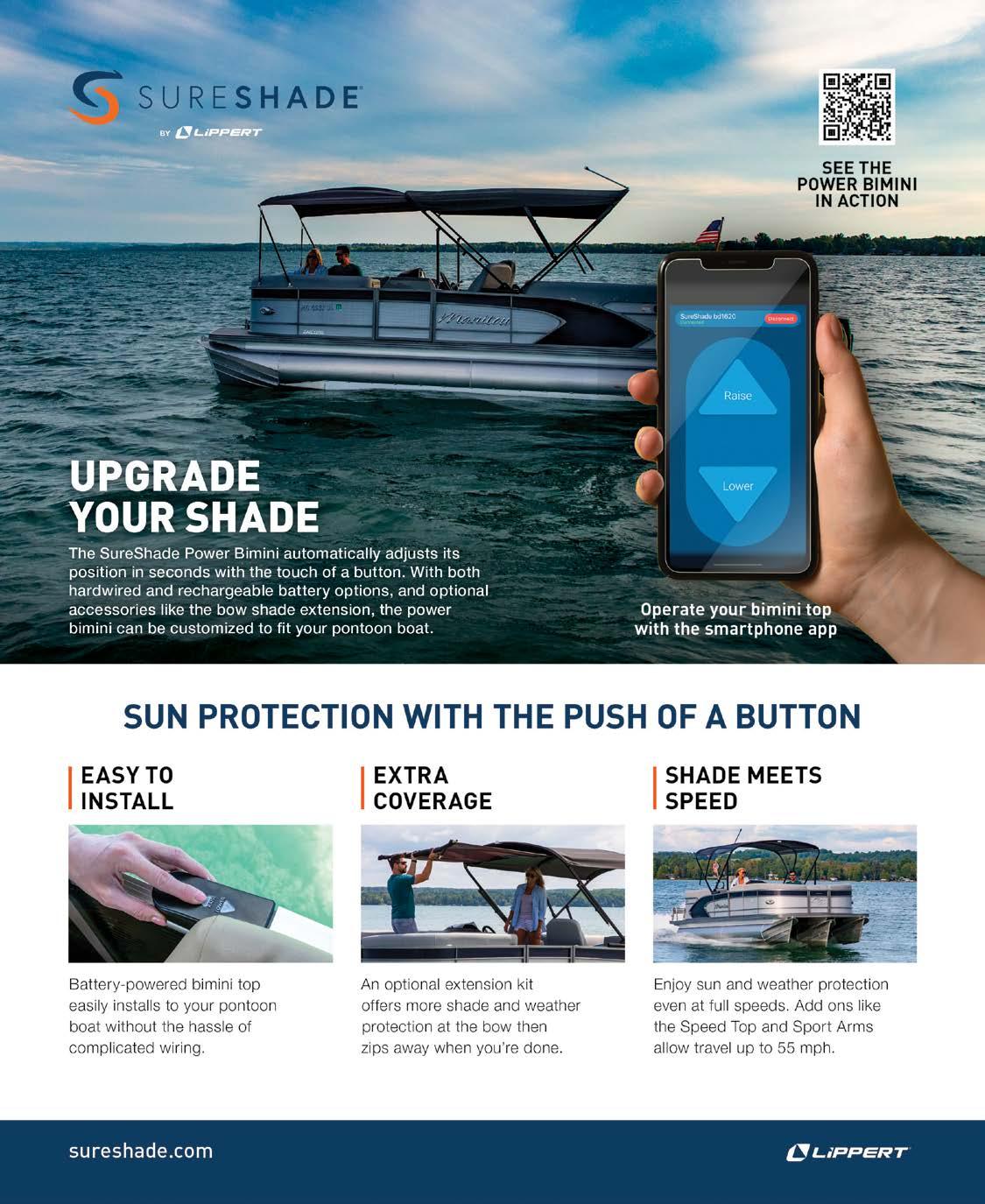
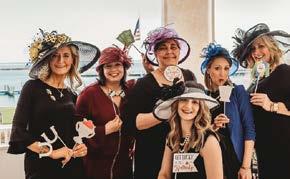


MAY 3 – 12
Biggest Week in American Birding
Oak Harbor, OH BIGGESTWEEKINAMERICAN BIRDING.COM
MAY 4
Can II Can Fishing Tournament Harbor Beach, MI
BLUEWATER.ORG
Derby Day Kelleys Island, OH KELLEYSISLANDCHAMBER.COM
1 Derby Day Soiree Mackinac Island, MI THEISLANDHOUSE.COM/ PACKAGE/DERBY
2 Door County Half Marathon Fish Creek, WI
DOORCOUNTYHALFMARATHON.COM
Wisconsin Marathon Kenosha, WI
WISCONSINMARATHON.COM
MAY 4 – 11
Tall Ships Dockside Tour Holland, MI
TULIPTIME.COM
MAY 4 – 12
3 Tulip Time Festival Holland, MI TULIPTIME.COM
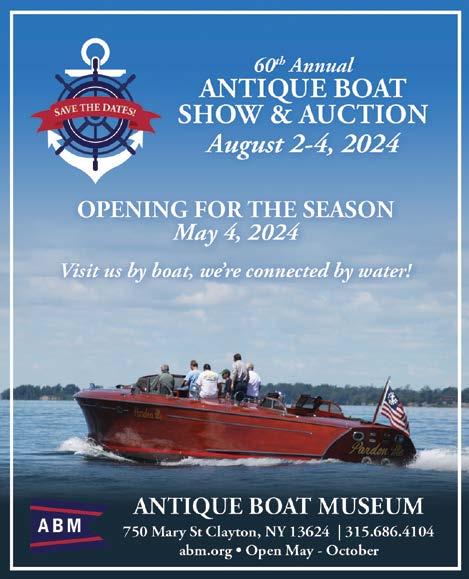
MAY 10 – 12
Jeep the Mac St. Ignace, MI STIGNACE.COM
MAY 11
Clay Days Clay Township, MI CLAYTOWNSHIP.ORG
Fort2Fort 5-Mile Challenge Mackinac Island, MI RUNMACKINAC.COM
MAY 14
Blessing of the Fleet Put-in-Bay, OH VISITPUTINBAY.COM
MAY 16 – 19
National Morel Mushroom Festival Boyne City, MI BCMORELFESTIVAL.COM
MAY 17 – 19
Midwestern Model Ships and Boats Contest Manitowoc, WI WISCONSINMARITIME.ORG
St. Clair River Marbleye Classic St. Clair, MI BLUEWATER.ORG
Zoo-De-Mack Harbor Springs & Mackinaw City, MI ZOO-DE-MACK.COM
MAY 18
Island Garage Sale Put-in-Bay, OH VISITPUTINBAY.COM
Lexington Fishing Tournament Lexington, MI BLUEWATER.ORG
Midwest Women’s Sailing Conference Milwaukee, WI MWSC.WILDAPRICOT.ORG
MAY 18 – 19
Great Lakes Boating Festival Grosse Pointe Shores, MI GREATLAKESBOATINGFESTIVAL.COM
The Kite Festival at Grand Haven Grand Haven, MI FACEBOOK.COM/KITEFESTATGH
MAY 18 – 24
National Safe Boating Week Nationwide SAFEBOATINGCAMPAIGN.COM
MAY 22 – 26
KitchenAid Senior PGA Championship Benton Harbor, MI SRPGACHAMPIONSHIP.COM/2024
MAY 23 – 25
Chequamegon Bay Birding and Nature Festival Ashland, WI BIRDANDNATUREFEST.COM
MAY 23 – 27
Walleye Festival
Port Clinton, OH MAINSTREETPORTCLINTON.ORG/ WALLEYE-FESTIVAL
MAY 24
Blessing of the Fleet South Haven, MI MICHIGANMARITIMEMUSEUM.ORG
MAY 24 – 26
Ride the Keweenaw Copper Harbor, MI VISITKEWEENAW.COM
MAY 25
Bayshore Marathon Traverse City, MI BAYSHOREMARATHON.ORG
Le Grand Du Nord Grand Marais, MN HECKOFTHENORTH.COM
Native American Festival St. Ignace, MI STIGNACE.COM
Petoskey Stone Festival Eastport, MI PETOSKEYSTONEFESTIVAL.COM
Stafford’s Top of Michigan Festival of Races Charlevoix, MI TRAILSCOUNCIL.ORG
MAY 25 – 26
Maifest Jacksonport, WI JACKSONPORT.NET/MAIFEST
Sturgeon Bay Fine Art Fair Sturgeon Bay, WI STURGEONBAY.NET
MAY 25 – 27
Memorial Weekend Derby Pentwater, MI PENTWATERPSA.ORG
MAY 26
Blessing of the Fleet Alexandria Bay, NY VISITALEXBAY.ORG
Lost Boat Ceremony Muskegon, MI SILVERSIDESMUSEUM.ORG
MAY 29 – JUNE 2
6 Aldo Leopold Festival Hessel, MI ALDOLEOPOLDFESTIVAL.ORG
MAY 31 – JUNE 2
Grosse Ile IslandFest Grosse Ile Township, MI GROSSEILEISLANDFEST.COM
� ADD YOUR EVENT! Email KBUSH@ LAKELANDBOATING.COM to add your event to our Calendar page.












































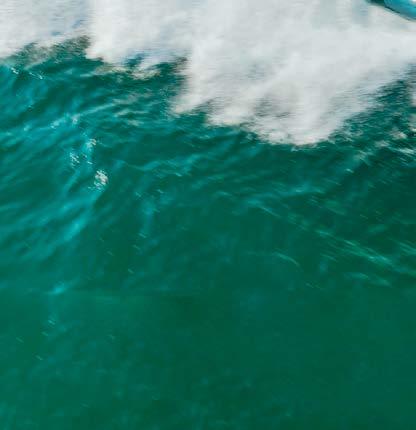






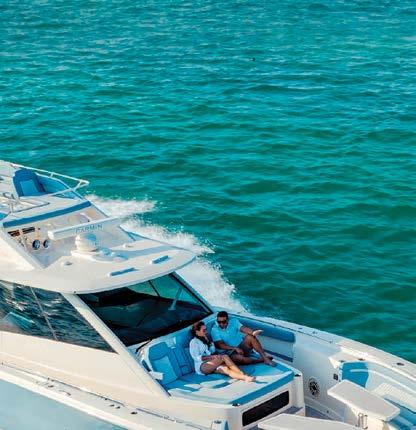
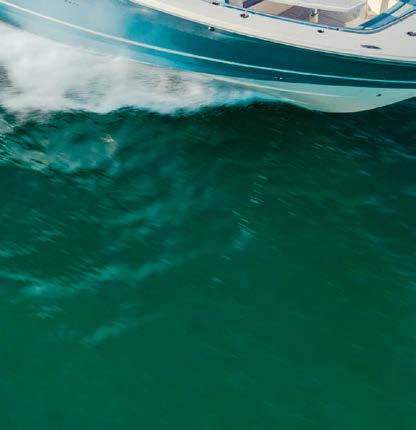




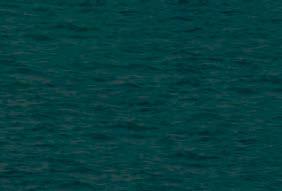









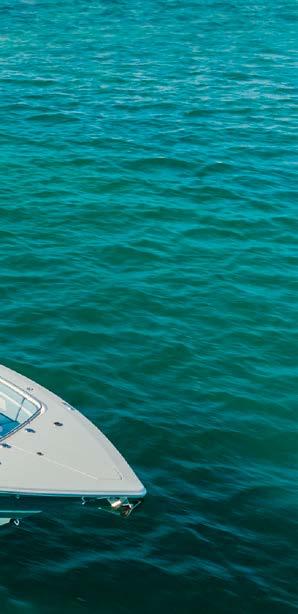
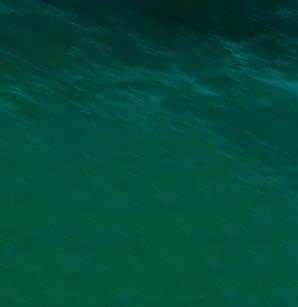
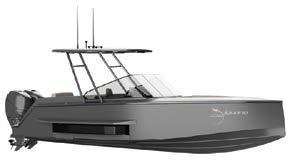
Iguana Will Debut New Bow Rider This Summer
Iguana Yachts has announced an addition to its lineup, specifically designed for the lakes of North America. The new Bow Rider features sleek, modern lines, along with a hardtop overlooking a new deck design. At the console, a windshield spans the entire width of the boat and can be enclosed with a waterproof enclosure between the windshield and hardtop.
“The Iguana Bow Rider is part of the expansion of our range launched in 2022 with the Iguana Sport then the Iguana Fisher, aiming to offer products more suited to the American market,” says Iguana Managing Director Julien Poirier.
Other features of the 30-foot boat include a heated cockpit, a large U-shape front seat with a table or sun lounger filler, eight strategically placed Bluetooth speakers, U-shape aft seating with a backrest and storage, and so much more.
The new model will debut this summer and is available for pre-order now. For more information, visit IGUANA-YACHTS.COM.
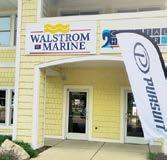
Walstrom Marine has a new sales location in Holland, Michigan, with slips at Yacht Basin Marina. Walstrom’s Dan Khodl and Jeff McGeorge will sell new boat models from Tiara Yachts, Regal Boats, Chris-Craft, Pursuit, MJM Yachts, Sea Ray and more.
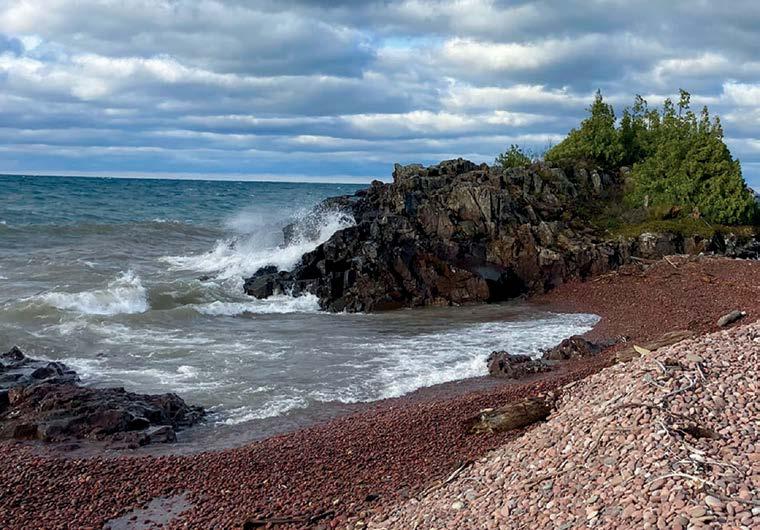


A 226-acre pristine parcel of waterfront land in Michigan’s Upper Peninsula has been conserved by the Superior Watershed Partnership and Land Conservancy, with the help of a $600,000 USDA Forest Service Great Lakes Restoration Initiative (GLRI) grant.
The land is considered part of Michigan’s Northwoods. It is 99% forested and features mixed forest types. The parcel was historically used as corporate timberland and was at risk of development up to the time of the project. The land features over a half-mile of Lake Superior shoreline with rocky outcroppings and secluded coves, and is home to
threatened or endangered species like the Canada lynx, gray wolf and northern long-eared bat.
“This acquisition serves as the keystone piece linking five other public access parcels in the contiguous Gratiot River Recreation Area, providing connectivity for the fishery,” says Neal Bungard, Community Forest program manager for the Forest Service’s Eastern Region.
The purchase of this land permanently links five local conservation areas, creating a contiguous 1,368-acre wilderness preserve protecting the lower Gratiot River watershed and 3.6 miles of Lake Superior coastline.


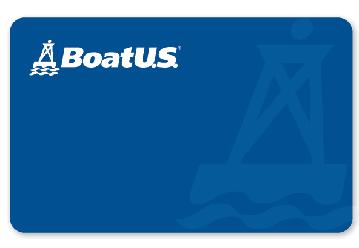
The Discover Boating Chicago Boat Show is moving from McCormick Place to the Donald E. Stephens (DES) Convention & Conference Center in Rosemont, Illinois in 2025, announced the National Marine Manufacturers Association (NMMA). The move will position the show for additional growth and help meet the boating industry’s and attendees’ needs.



The DES Convention Center is centrally located just 15 miles northwest of downtown Chicago and offers 840,000 square feet of exhibition space, nearby restaurants, hotels, shops and entertainment, with a host of transportation options.
“The Chicagoland area is a hub for tourism and events, and the Village of Rosemont is no exception with its convenient location, close parking and great amenities,” says Christopher Stephens, executive director of the Donald E. Stephens Convention Center. “On behalf of Rosemont and the DES Convention Center, we are pleased and honored to welcome the Discover Boating Chicago Boat Show to its new home and show exhibitors and both current and future boaters all that Rosemont has to offer. We look forward to carrying on this Chicago tradition and are invested in continuing this partnership with the NMMA.”
exception with its convenient location, close
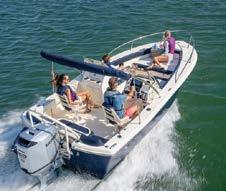
Honda Marine has partnered with Scout Boats to offer the Honda Seabrook Series Boats — all-new, highperforming boats built exclusively for Honda by Scout and powered by Honda Marine BF150 iST outboards.
Buyers can select between the 19.5-foot Seabrook Center Console or 19.5-foot Seabrook Dual Console models, available in five different trim levels. The Honda BF150 iST outboard is offered in three versions: Base, Sport and Fishing.
The models have an easy-to-operate, dashboard-style helm integrating Honda digital controls with BayStar by Dometic hydraulic steering, and a Garmin 9-inch SONAR/GPS. Features include comfortable, UV-protected upholstered seats, a rear swim platform with a ladder, a ski tow bar, collapsible Bimini tops (standard on Sport packages), and an Igloo Marine Ultra cooler and aerated baitwell (standard on center console Models). Options include boat and engine covers, a battery charger, a trolling motor (Fishing package only), an anchor and a head.
Honda Marine has adopted the streamlined consumerfriendly Honda automotive online shopping experience. Consumers can easily design their boat, see a 360-degree rotating image of the boat, and then be directed through retail financing, submitting the order to the closest dealer for delivery.
To learn more, visit CHICAGOBOATSHOW.COM.
Visit MARINE.HONDA.COM/SEABROOK-BOATS.

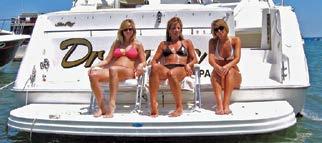
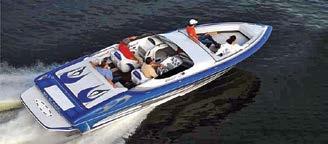
thousands shipped to satisfied customers.
We provide boaters with superior products and outstanding customer service. once you order one of our Swim Platforms, you will not only enjoy all the benefits of having the extended space on your boat — you will be the envy of every boater at the dock!
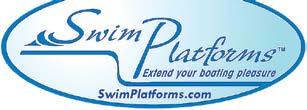
3220 S. 38th Street Phoenix, AZ 85040 602-431-8225

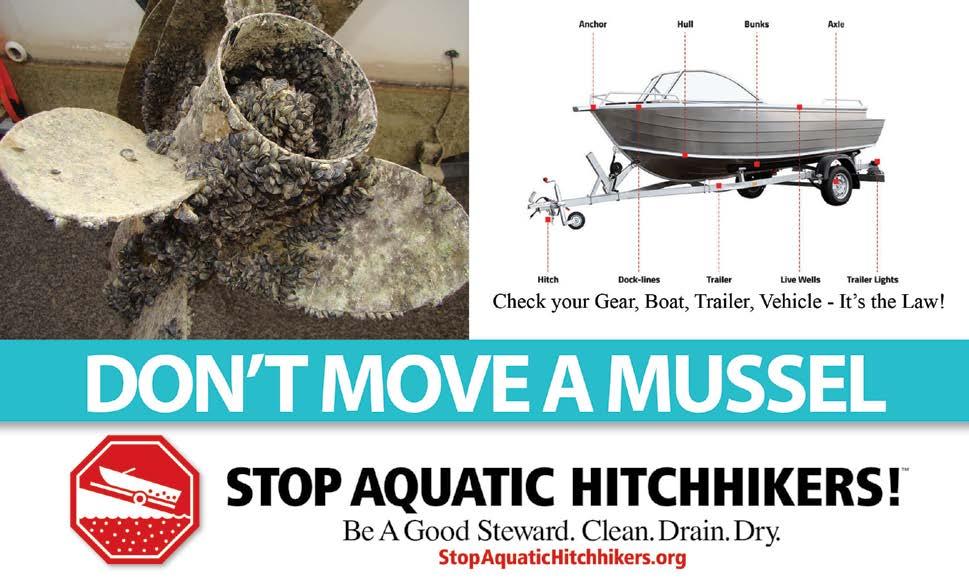

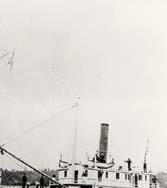

Researchers at the Michigan Shipwreck Research Association (MSRA) have discovered the remains of the 135-foot-long, remarkably intact steamship Milwaukee, which sank in 1886 after it was struck by another ship 40 miles from Holland, Michigan, in 360 feet of water. The discovery was announced to a live audience of 300-plus people at the Knickerbocker Theater in Holland, at the MSRA’s annual film festival in May.
“This marks the 19th shipwreck our team has found off the shores of West Michigan” says Valerie van Heest, who with her husband, Jack, coordinated the search effort. MSRA discovered the shipwreck in June 2023 using side-scan sonar. Milwaukee was built in 1868 by the Northern Transportation Company of Ohio, which was among the earliest steamship operators on the Great Lakes. Read more about Milwaukee at MICHIGANSHIPWRECKS.ORG.
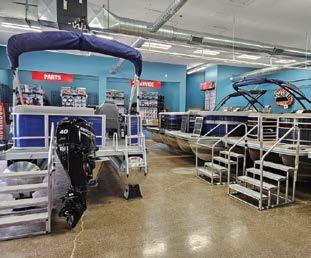
The family-owned boat dealer Hall’s Sport Center just opened its new store in Comstock Park, Michigan, just north of Grand Rapids and right off U.S. Highway 131. The new space sits on four acres with 37,000 square feet split between five buildings, and offers new and used boats and repair services.


“This location is just going to be great for our customers to either stop on the way up (north) or stop on the way back, when boating is fresh in their mind,” Hayden Hall, the company’s general manager and son of owner Harold Hall, told Crain’s.
Hall’s Sport Center purchased the location for nearly $3.3 million in February 2024, and plans to invest between $6 and $10 million into a new 40,000-squarefoot, two-level showroom.
Hall’s Sport Center also has locations in Muskegon and Grand Haven, Michigan.
For more info, visit HALLSSPORTCENTER.COM.

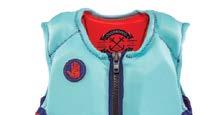
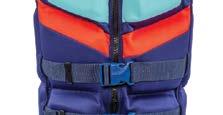







Buckle up before enjoying your favorite watersport. Body Glove’s Overboard PDF features an extended contoured body and beveled soft PVC front foam floatation for reduced bulk and maximum flexibility. U.S. Coast Guard and Transport Canada approved. Features Evoprene outer shell, two heavy-duty 1.5-inch belts with quick-release buckles and concealed backside buckle straps. Available in three color combos. $109.99 AT BODYGLOVE.COM
2. Stream2Sea SPF40
Zinc Balm Sunscreen
Protect yourself from the sun’s harmful rays with this natural formula, offering a sheer, non-greasy protective barrier that’s also safe for fish. The new sunscreen is formulated with EcoSafe Zinc and made with only nine simple ingredients. The concentrated water-free formula is 100% USDA Certified Bio-based and contains no synthetic preservatives or fragrance. Provides at least 80 minutes of water-resistant protection. Gentle enough for children over 6 months of age and those with sensitive skin. Packaged in an recyclable and reusable aluminium container with a screwtop lid. $24.95 AT STREAM2SEA.COM
Must-have goodies, gadgets and more for every boater


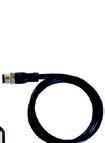
The new USCG-approved electronic visual distress signal (eVDS) provides boaters with an alternative to pyrotechnic flares (when used with the provided distress flag). The ODEO SOS is a high-intensity strobe light providing an internationally recognized SOS Morse signal. Utilizing powerful LED lighting technology, the easy-to-use device offers enhanced visibility, ensuring that distress signals are easily spotted. Waterproof to 16 feet and has been tested at depths of 165 feet.
AT DANIAMANT.COM
Be prepared for a day on the water with this set of engine kill switch keys for personal watercraft or outboards. Compatible with Yamaha, Evinrude, Honda, Mercury and Johnson engines, the six keys are conveniently attached to a lanyard. In the event of a MOB situation, the kill switch key will instantly shut off the engine. The swiveled clip keeps the lanyard from tangling. $12.99 AT WESTMARINE.COM

5.
Carbon monoxide (CO) is known as a silent killer; odorless, tasteless and generated from incomplete combustion from engines, generators, etc., it’s a real threat to boaters. Digital’s Yacht’s new CO Alert system is a carbon monoxide detector and alarm with NMEA 2000 integration, so alerts will pop up on the boat’s MFD in addition to loud, audible alarms in cabins. $349.95 AT DIGITALYACHTAMERICA.COM
Fight fire with these new U.S. Coast Guardapproved fixed aerosol fire suppression systems. The compact system is ideal for spaces onboard containing lithium-ion batteries, or areas that cannot accommodate a traditional fire suppression system, such as generator or compact engine compartments. When ambient temperatures reach fire conditions the Sea-Fire AT-series systems automatically discharge the highly effective yet eco-friendly aerosol agent. Installation is easy, and the device has a service life of 15 years. Available in six model sizes from 19.4 up to 642 cubic feet of volume protection. AT SEA-FIRE.COM





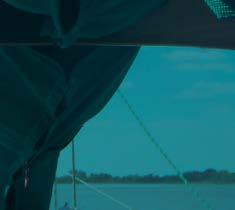
Nothing epitomizes good seamanship like standing a proper watch. Here’s how to prepare for your watch and how to do it correctly, be it an overnight trip or a voyage around the world.
For the purpose of this article, we’ll assume watch details, such as the rotation and number of crewmembers on watch, are settled. The focus here is to help you prepare for your watch.
1. Read the captain’s orders. Most captains will have written rules or Standard Operating Procedures (SOP) to provide guidance and assist the crew with decision-making while the captain is below decks or otherwise not immediately available. Common things contained in an SOP include safety procedures when standing watch (such as staying in the cockpit at night), frequency of and reasons for logbook entries, and when to alert or wake the captain (weather changes, equipment problems or collision avoidance issues). Regardless of what reasons are listed, always alert the captain if in doubt or you have a question that affects the safety of the vessel and crew.


2. Familiarize yourself before going on watch. Make time to familiarize yourself with all navigation and electronic equipment before going on watch. Learn how to operate the VHF radio, chartplotter, RADAR and AIS, as well as how to scroll through and access various functions for each.
In addition to navigational alarms, knowledge of vessel monitoring and warning systems you may hear or see (engine alarms, smoke alarms, CO detectors, high-water bilge alarms) are also crucial.
3. Get rest. Try to get a minimum of 5 to 6 hours of sleep before going on watch — longer if your watch rotation allows it. This is particularly good advice when standing a night watch. Even if you can’t sleep when off watch, you should still rest.
4. Dress appropriately. The weather while boating is dynamic and ever-changing; a warm summer evening
can quickly turn cool after dark, while a squall can bring high winds and torrential rain to the sunniest of days. Be prepared and properly outfitted with the correct clothing and foul weather gear when reporting for watch.
5. Have proper personal gear. While requirements will vary, the following is a good start.
• Waterproof flashlight and headlamp (for hands-free operation) with both white and red light options (to preserve night vision)
• Knife or multitool
• Timepiece — sure, you can use a cellphone, but going old-school with a waterproof wristwatch eliminates phone disasters and is the bomb!
• Personal PFD and harness (or even better, a PFD with integral harness) and tether
• Water bottles and other beverages (such as electrolyte drinks)
• Light snacks
• Sunblock
• Seasickness medication
• Sunglasses
• Binoculars
• PLB (Personal Locator Beacon)
1. Maintain priorities. There’s no ambiguity when it comes to what your priority must be when standing watch. In fact, the Convention on the International Regulations for Preventing Collisions at Sea (COLREGS) defines it in a single sentence: “Every vessel shall at all times maintain a proper look-out by sight and hearing as well as by all available means appropriate in the prevailing circumstances and conditions so as to make a full appraisal of the situation and or the risk of collision.”
While the term “all available means” includes collision avoidance methods that seaman have used for centuries (i.e. staying alert and maintaining a good lookout) for today’s mariner it also encompasses the use of modern electronics like radar, AIS and VHF radio. Get the most from these devices by developing a routine of scrolling through the radar ranges, zooming in and out on the chartplotter, and checking the AIS system throughout your watch. However, avoid overreliance on electronics and the complacency it can generate; never let a glance at
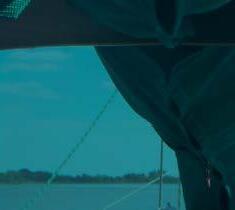
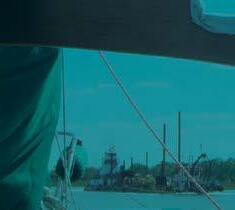
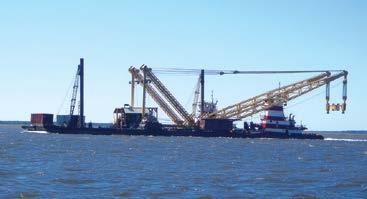
the radar or chartplotter replace making a visual sweep of what’s going on around you.
2. Scan the Horizon. Develop a habit of conducting a 360-degree scan of the horizon every 10-15 minutes, both with and without binoculars.
3. Mind your helm. While they are a boon to shorthanded watches, autopilots make it easy to forget or stray from something as simple as maintaining course. Like their human counterparts, they are not perfect and can subtly introduce navigational errors due to issues such as low power or human error.
4. Maintain the log per the captain’s SOP. Logbook entries underway are typically made every hour on the hour and can include everything from engine temp and oil pressure to navigational information such as vessel speed, heading, direction and position.


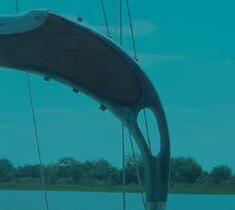



Make sure you brief your relief.
“Always have a standard briefing when changing watches,” says Capt. Zuzana Prochazka, owner of Zescapes custom charters (ZUZANAPROCHAZKA.COM).
Keep it simple, but precise and clear. What’s the course and speed? Sea state? Current and expected weather? Any radio contacts? Vessels sighted and, if so, where are they now?
“Include comments on items such as weather, condition of boat/engine, sea state, traffic, course changes and any engine or proximity warning alarms you may have set,” advises Capt. Prochazka, “then have the oncoming (and possibly sleepy) watch repeat back what they just heard.”


















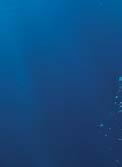







 CAPT. FRANK LANIER is an award-winner journalist, boat maintenance guru and owner of Capt. F.K. Lanier & Associates, Marine Surveyors and Consultants. Check out his YouTube channel "Everything Boats with Capt. Frank Lanier." CAPTFKLANIER.COM
Keeping a proper look-out is the prime directive for everyone on watch.
CAPT. FRANK LANIER is an award-winner journalist, boat maintenance guru and owner of Capt. F.K. Lanier & Associates, Marine Surveyors and Consultants. Check out his YouTube channel "Everything Boats with Capt. Frank Lanier." CAPTFKLANIER.COM
Keeping a proper look-out is the prime directive for everyone on watch.
It is irrefutable that emergency beacons save lives and that every boater should have one. If you don’t have one onboard or you need to replace an aging beacon, now is a great time to consider getting one of the most feature-rich EPIRBs or PLBs available.



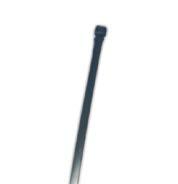




EPIRBs (Emergency Position Indicating Radio Beacons) are designed to be registered and mounted on vessels. Most EPIRBs, when triggered either automatically or manually, send an encoded distress signal via satellite along with a homing radio signal to aid in a rescue. PLBs (Personal Locator Beacons), as the name suggests, are personal beacons that can be carried on the person and operate in the same way as EPIRBs but must be manually triggered. However, new features that are now available on both types of beacons make them even more effective in summoning help.

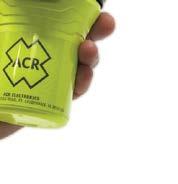
ACR Electronics, a worldwide leader in emergency beacons, has recently introduced a new line of EPIRBs and PLBs with three new features that make up the next generation of emergency beacons.
One new feature, known as Return Link Service, or RLS, lets the user know that their emergency signal and location have been received by emergency personnel. When an EPIRB or PLB is activated by the user in an emergency, a signal is transmitted from the beacon to the worldwide Cospas-Sarsat search and rescue satellite network. This satellite network then relays the information via land-based transmission towers to emergency centers that then determine the nearest search and rescue response. While all of this still occurs with the new beacons, they are now also able to get return confirmation that the signal and position have been received, giving those in an emergency the peace of mind that someone received the signal and help is on the way. Some models have an LCD screen that will show a message indicating the signal has been received, while others have an LED light that activates when the confirmation has been made with the beacon.


Another feature now available on ACR’s new beacons is AIS (Automatic Identification System) capability. This system functions as an MOB (man overboard) rescue system. When the beacon is activated, it also transmits an AIS signal via VHF radio frequencies. Vessels within range of those VHF signals that have AIS receivers (all commercial vessels of a certain size along with a growing number of recreational vessels) will automatically get an MOB icon pop-up on their display indicating a man overboard or distress situation and the location. In many cases, this could result in a faster rescue of those in trouble.
Although AIS is not a new technology, it has only recently been available on EPIRBs and PLBs. Now, when activating either type of beacon, if there is a vessel nearby monitoring AIS, help could be even closer.
The third new offering on some ACR EPIRBs and PLBs is Near Field Communication. This technology can give owners of equipped ACR EPIRBs and PLBs the ability to view diagnostics on their smartphones. By simply touching or holding a smartphone loaded with ACR’s app next to the EPIRB, the app will automatically open and display the EPIRB’s diagnostics. The app will show information such as: Completed self-tests; battery life; completed GNNS tests; how long it took to lock onto and get a position from the GNN; how many satellites it locked onto to get the position; and the accuracy of the position (usually less than 100 meters worldwide). It even will show where the test was completed on a map within the app.
What is particularly interesting about this feature is that it doesn’t use the valuable internal battery of the EPIRB to gather all this information; instead, it uses the battery power of the smartphone. It’s a great way to check an EPIRB and know its condition on a regular basis.
Boaters who end up with one of these extremely well-equipped EPIRBs or PLBs, such as the ACR GlobalFix V5 AIS EPIRB or the ACR ResQlink AIS personal locator beacon, will have a device that will be able to notify and get help in an emergency easier than ever.



Maneuvering over waves and wakes is a normal boating occurrence, yet it’s how we handle them that determines if the experience will be easy, daunting or dangerous. With knowledge and experience, going through waves will be easier and less frightening. An online tutorial or a refresher
course, like the America’s Boating Course offered by the Coast Guard Auxiliary (CGAUX.ORG) or America’s Boating Club, (AMERICASBOATINGCLUB. ORG) may be helpful. So, what do you know about waves, and what do you do when you approach a wave or wake? Take this quiz and find out.
A. True or False (T or F)?
___ 1. Sandbars or rock outcroppings can cause breaking waves.
___ 2. A boater should steer the bow into waves or wakes.
___ 3. Back off the throttle and come off plane before taking a wake.
___ 4. Usually, taking a wake at a 45-degree angle works best.
___ 5. Practice taking wakes at different speeds to judge future impact reactions.
___ 6. It’s best to throttle up, take the wake higher than cruising speed and ignore trimming the boat.
___ 7. Waves hitting the stern may cause taking on water.
___ 8. Waves hitting broadside may capsize the boat.
___ 9. Take waves on the bow.
___ 10. Excessive wakes cause shore erosion, move bottom sediment and dislodge animal habitats.
___ 11. Look before you turn your boat and slow down to reduce your wake.
___ 12. Refrain from boat tricks near other boats or shorelines.
___ 13. Early morning tends to have less boat traffic to avoid boat wakes.
B. Match the Definitions
1. Boat Wake
2. Trimming the Boat
3. Ballast or Passenger Weight
4. Hull
5. Propulsion
6. No Wake Zone
C. Handle a wake in the correct order:
A. Designated areas not to be disturbed by wakes.
B. Boat shape that determines wake shape.
C. Power to move the boat through the water.
D. Waves produced by boat speed and size.
E. Causes water displacement behind the boat.
F. Adjusting the boat’s surface areas to perform better.
___ Trim the boat and slow down before crossing the wake.
___ Seat passengers for comfort and place more weight in the stern.
___ Watch what’s coming ahead and plan accordingly.
___ Always wear your life jacket.
___ Steer the bow into the wake but keep the speed constant over waves.
D. Good or Bad Practice (G or B)?
___ When waves bounce off the shoreline and other boats’ waves, it’s best to keep the boat idling.
___ Stay 150 feet away from docks, structures and shorelines.
___ Minimize repetitive passes and close shoreline encounters.
___ Don’t pass closely to other boats.
___ Tow your towables in a predicted path for other boats to avoid the wakes.
___ Don’t impede traffic with your actions.
Safety First.

Introducing today’s youth to smart and safe boating.
As parents and caregivers, we do our best to prepare our children for major milestones, like the day they receive their driver’s licenses. We know we must arrange driver’s education courses and ensure that our new drivers get plenty of supervised hours behind the wheel.
Yet, how many of us are also preparing our youth to safely operate a personal watercraft, fishing boat, watersports boat or family cruiser?
Safety is just as important on the water as on the road. Perhaps more important, according to Ted Sensenbrenner, director of boating safety at the BoatUS Foundation for Boating Safety and Clean Water, and U.S. Coast Guard Auxiliary Flotilla Staff Officer Dan O’Connell.
“A common misconception is that once you hit the water, you can do anything you want,” Sensenbrenner adds. “There are no lanes like on a road, and no traffic signs warning you of dangerous curves. You have to constantly pay attention and keep your boat in control. That means always maintaining a proper lookout, resisting distractions, being aware of surroundings and other boat traffic, and operating at a safe speed.”
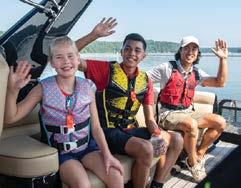
“It’s deceptively easy to get in and drive (a boat), but big or crowded water is unforgiving if you try to learn by trial and error,” O’Connell says. “Would you turn car keys over to a teenager and just wish them luck? Without a boat operation or safety class, that’s essentially what you’re doing.”
O’Connell has 50 years of experience handling boats, 26 of them in the U.S. Navy. He joined the U.S. Coast Guard Auxiliary in 2014 to educate the public about smart and safe boating.
“I enjoy sharing knowledge and wisdom,” he explains. “I teach boating safety, GPS, coastal navigation — whatever the marketplace wants to learn.”
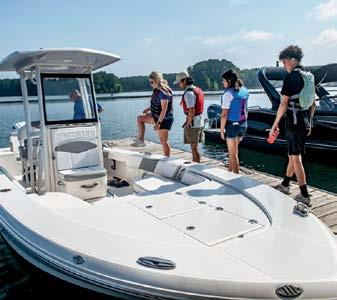
The U.S. Coast Guard Auxiliary has a family of products tailored to young people. At the entry level is “Kids and Boats,” which teaches third and fourth graders using an activity-focused, kid-friendly presentation.
“Pre-COVID, we’d teach boating safety every May at schools on Chicago’s North Shore,” O’Connell says. “The kids would do relay races with life jackets, and learn
things like how to get in and out of a boat safely, and what to do if a friend falls in the water.”
At the middle and high school levels, the program still incorporates some hands-on elements, but it also introduces material from the adult USCG Boat America course. This is particularly true for older students, who can operate a boat legally.
“We get them to the point they can take the fullblown Boat America course, which is approved by NASBLA (National Association of State Boating Law Administrators),” O’Connell explains. “We give people the basics, plant seeds and encourage them to go have fun.”
“Don’t think of classes as a way to just meet the requirement, but as a way to further your knowledge about a hobby and skills that will last a lifetime,” Sensenbrenner says. “Think of it as investing in yourself.”
He cites benefits such as building confidence, improving situational awareness and engaging in a learned safety culture. Boater education and safety courses prepare young people to be in control of a vessel, with the knowledge necessary for a safe day on the water.
“As the vessel operator, you have an awesome responsibility for all aboard, to ensure everyone has a good time and all come home safely,” Sensenbrenner says.
Most states have boating education requirements, phasing in those requirements starting with the youngest operators. O’Connell encourages families to research their own state’s requirements.
“In Illinois, you cannot operate a boat over 10 hp under 10 years old,” he advises. “At 12 (years old), you can, but only if you’ve taken a safety class, and the state will want to see proof of completion. This is like a license; states call it different things.
“Every state I know says you must have that license if you’re X years old or younger,” he adds. “For example, in Illinois, that age is 26. In Wisconsin, it’s 35.”
Who signs up for the U.S. Coast Guard Auxiliary’s full, eight-hour Boat America course? Participants are every age and from all walks of life — but if they are 18 and under, they probably do not get there on their own, O’Connell notes with a laugh.
“Responsible parents want to teach their kids, so young people tend to come in through a side door,” he says. “You’ll have kids who want to drive the Jet-Ski or the fishing boat, and to do it legally, Mom and Dad say they have to take the class. Then you’ll have the teens who are rolling their eyes, so the parents say, ‘We’ll take the class too.’
“Sometimes we get whole groups,” he continues. “One person has to take the class, they recruit others, and then they all learn together.”
On one memorable occasion, a parent wanted her two sons to take the class, but they were too busy with baseball practices and games. So she worked with O’Connell to arrange a class time that would work, and half the baseball team showed up.
“If you have interest, we’ll work with you in whatever way is most practical and possible,” he says. “This is too important not to do. Lifetime habits start early.”
Online courses are also a great option. The BoatUS Foundation offers a free online safety course that is accepted in 36 states. According to the foundation, more than 2.5 million people have taken the course to date — including youth.
“It’s well established that children are likely to acquire new knowledge and skills more rapidly than adults,” Sensenbrenner notes. “It’s also well established that it’s better to learn something correctly the first time, so you don’t have to unlearn poor habits and replace them with new (ones).”
Those poor habits can lead to disaster. The U.S. Coast Guard’s 2022 recreational boating statistics indicate that 50% of accidents, injuries and deaths occur among boaters with less than 100 hours of boating experience, and a disproportionate 20% of injuries and fatalities involve operators who were less than 26 years old.
“Most fatalities are drownings — 87% were not wearing a life jacket,” O’Connell says with a sigh.
An important early lesson for youth: Life jackets are critical. Good swimming skills won’t help you
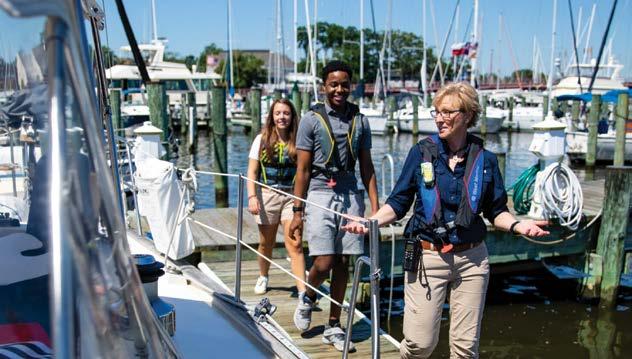
if you hit your head going overboard — or if hypothermia strikes. Lake Michigan’s average water temperature is 52.3 degrees in June; within 10 to 15 minutes, you lose your ability to swim.
Sensenbrenner notes that young people might think of life jackets as bulky, uncomfortable and uncool. He encourages parents to shop with their kids, outfitting them with contemporary, lightweight life jackets, SPF-rated shirts and quick-drying shorts.
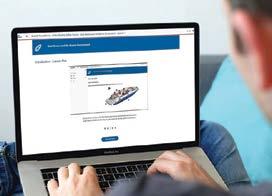
He also recommends introducing them to positive role models. They might be real people in your life, or influencers like professional angler Hunter Bland. Bland became a boating safety advocate after a 2017 accident in which he was thrown from a boat moving at 55 mph.
You’ll also want to make sure your kids have plenty of time behind the wheel in a safe environment. If you’re interested in signing them up for on-water classes, check with the BoatUS Foundation (see Resources box) as well as your local boat/yacht clubs and boat-sharing businesses like Freedom Boat Club.
You also can hire a USCG-licensed captain, or collaborate with experienced family members and friends. Encourage your kids to practice skills like anchoring, docking and man-overboard drills.
“Practice, practice, practice, and remember that every boat is different,” O’Connell says. “Operating a boat is a lot of fun, but it must be taken seriously too.”
Boating education comes in a variety of formats, including on-water, hands-on classes or online boating courses.

America’s Boating Club
Founded in 1914, America’s Boating Club
offers a boating safety course and state certificate preparation: AMERICASBOATINGCLUB.ORG
Boat-Ed
Official boater safety courses and boat safety education materials, recognized by the USCG and approved by NASBLA, your state boating license agency and Transport Canada. Choose United States Boater Safety Courses by state: BOAT-ED.COM
Boat Safe Great Lakes Skipper Club for teens ages 13-19: BOATSAFEGL.COM
National Safe Boating Council Skipper Club for teens ages 13-19: SAFEBOATINGCOUNCIL.ORG/TRAINING
BoatUS Foundation Free, online, state-specific boating safety courses: BOATUS.ORG/FREE On-water training: BOATUS.ORG/ON-WATER
Sea Scouts
Part of the Scout movement, Sea Scouts focus on powerboating, sailing and other water-based activities: SEASCOUT.ORG
U.S. Coast Guard Auxiliary Boat America and other courses: USCGAUX.ORG/BOATINGED
U.S. Power Squadrons
America’s Boating Course: AMERICASBOATINGCOURSE.COM
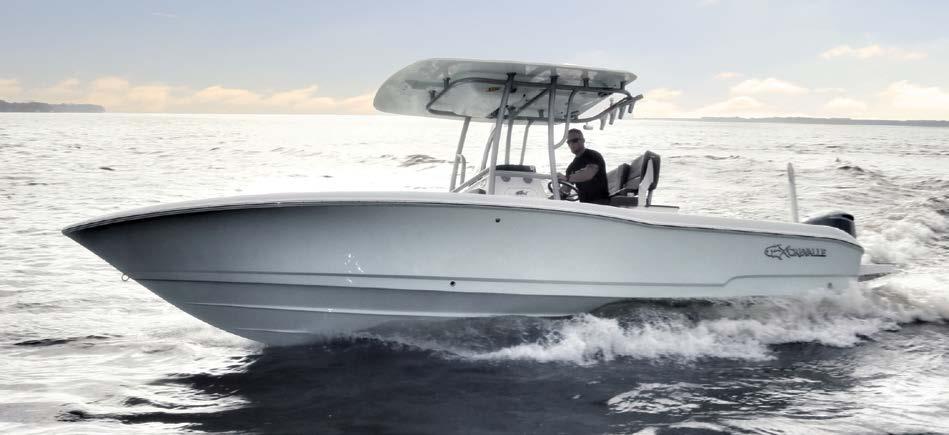
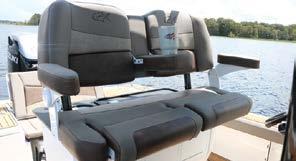

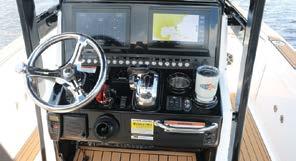
SPECIFICATIONS
LOA: 25'6"
Beam: 8'6"
Draft: 12" – 14"
Deadrise: 16°
Weight (w/ out motor): 4,000 lbs.
Fuel Capacity: 90 gals.
Power: 300- to 400-hp outboard
MSRP: Contact dealer CREVALLEBOATS.COM
ith the previously launched Crevalle 24 HCO a hit with its owners, the only thing to do for this builder was to go bigger. Adding more room, features and power, the Crevalle 26 HCO is the kind of bay boat that is as versatile inshore as she is offshore or out for a day of cruising.
“The Crevalle 26 HCO delivers on the promise of a hybrid family fishing boat for the hardcore fishermen,” says Mark Felhofer of Bay Marine.
Her flexibility as a family boat and fishing platform is apparent from bow to stern. Construction-wise she is sturdy resin-infused composite-built to take the elements, and the company stands behind its products, as evidenced by the 10-year transferable hull warranty.
Standard features include a custom forward deck cushion package with an easily removable/reversible molded backrest, a portside swim platform with a telescoping stainless steel ladder and dual 12-inch Garmin or Simrad multifunction displays.
Fishing features abound, including pre-wiring for a trolling motor, a trio of livewells, a custom fiberglass leaning post with rigging tray, tackle storage, a sink, a removable cooler and four rod holders.
Captain the boat underneath the protection of the MY 2024 fiberglass hardtop with a powder-coated frame, three-sided embedded glass, overhead LED lights, a mister system and two speakers. Outboard power options include a choice of Yamaha, Mercury or Suzuki.
“As equally impressive as its functionality is, the ride eats up rough water,” Felhofer adds.
Comfortable with its boutique boat builder profile, Crevalle has honed its expertise away from mass production and instead focuses on each individual boat and the needs of its owner.
The Crevalle 26 HCO is a prime example of the company’s building principles, and once you take a ride, you’ll see why.

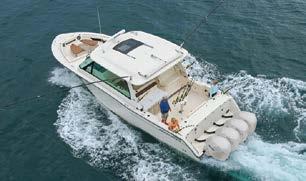
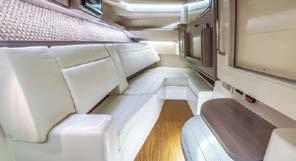
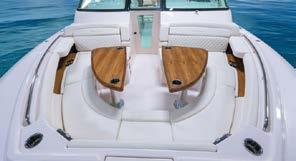
Grady-White is an industry mainstay for innovation and a superior build, and the new Freedom 415 dual console bridges the gap between a major fishing platform and a boat with luxury cruising capabilities.
“Nothing was left to chance on this new model,” says Christian Carraway, Grady-White’s product designer. “Every inch has been examined and reexamined to ensure it hits the highest marks for the serious fishing crew and those who want to cruise.”
Riding on its award-winning SeaV² hull, the Freedom 415 has a variable vee configuration that sharpens from the transom to the bow. Coupled with a high freeboard, bow flare and strakes, the results are a smooth ride, conditions permitting, at any speed. And when conditions go south? Well, it is a Grady-White, after all.
Taking its cues from the admired Canyon 456, the Freedom 415 is outfitted with the kind of upscale amenities making her quite the comfortable cruising boat as well as her formidable fishing profile. To that
end, her extensive standard equipment includes a bow thruster, a Seakeeper 6 gyro stabilization system, a lit 459-quart aft insulated fishbox with overboard drain, a refrigerator/freezer with a digitally controlled thermostat, two 35-gallon raw water aft port and starboard insulated livewells, and many other amenities. Her impressive power is provided by a quartet of Yamaha XTO Offshore 450-hp outboards.
Sliding doors lead to the port console cabin and the starboard head compartment. The cabin offers a private retreat, outfitted with custom-made oak cabinets with cane inlay doors and woven seagrass cloth-covered walls, full-size aft and forward double berths, a microwave and a 24-inch TV. The starboard head console features a shower, a vanity, custom-made cabinets, a hand-hammered nickel sink and teak floors.
“Our customers have been anxiously awaiting a larger dual console model and this terrific boat over-delivers,” says Joey Weller, vice president of sales.
SPECIFICATIONS
LOA (w/o engines): 40'7"
Beam: 13'8"
Draft: 34"
Weight: 22,950 lbs.
Fuel Capacity: 536 gals.
Water Capacity: 55 gals.
Max Power: 1,800 hp
MSRP: Contact dealer GRADYWHITE.COM
South Shore Marine SOUTHSHOREMARINE.COM
Desmasdon’s Boat Works DESMASDONS.COM
Drummond Marine DRUMMONDMARINE.COM
Jerry’s Majestic Marine JERRYSMAJESTIC.COM
The Boat House BOATHOUSEH2O.COM
Mega Powersports and Marine MEGAPOWERSPORTS.COM
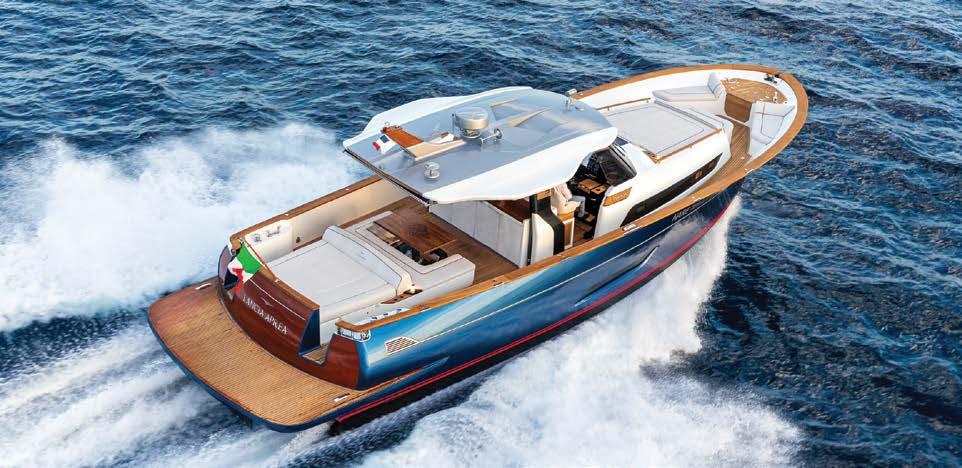

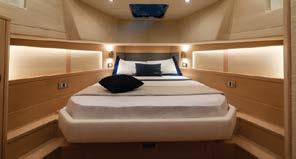
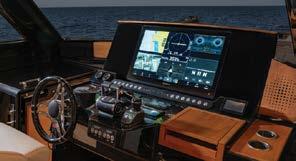
SPECIFICATIONS
LOA: 50'2"
Beam: 16' Draft: 2'7"
Displacement: 22 tons
Fuel Capacity: 660.4 gals.
Water Capacity: 145.3 gals.
Power: 4 x Mercury Verado
600 hp; 2 x Man i6-800 800 hp; 2x Volvo Penta IPS800
MSRP: Contact dealer LANCIAAPREA.COM
DEALER
Fratelli Aprea Sorrento 1890 USA, LLC Boyne City, MI 313-908-3818
FRATELLIAPREAUSA.COM
he renowned Naples, Italy-based Victory Design studio, under the expertise of Brunello Acampora, was on a mission: To successfully reinterpret and modernize the much-admired and chosen by European glitterati, the 1950s Lancia Sorrentina. The result is the splendid Lancia Aprea 52, a luxurious, high-performance yacht — the first of proposed models from 31 to 72 feet.
“Six generations of family boat building has resulted in a new adventure, taking Lancia Aprea into the 22nd century with modern composite construction and an up-to-date interpretation of boats with historical significance,” says Michael Sinacola, president of Fratelli Aprea USA.
The Lancia Aprea 52 presents the lower deck in two configurations for the American market. The Cruise plan is complete with a pair of staterooms, one head and a settee, while the Lounge Cruise plan offers two cabins, one head and a forward dinette.
Getting fore and aft to the sunpad areas is easy and safe via deep walkways on either side. The helm is a work of art, and directly behind is a dining table.
There is a range of power options, including twin 800-hp MAN i6 or twin 800-hp Volvo Penta IPS diesel inboards, while quad 600-hp Mercury Verado outboards are also optional.
“The Lancia Aprea 52 presents Italian artisanal artistry along with American collaboration, and will be at the 2024 Fort Lauderdale Boat show,” Sinacola says.
The Lancia Aprea 52 is a stunningly beautiful yacht that is sure to be a head-turner wherever she goes. Comfort and performance are part of her DNA, and her legacy of robust construction is something that rings true the moment you step aboard. If a yacht like this one is up on your radar screen, you owe it to yourself to schedule a walk-through and have the opportunity to take the wheel. You will not be disappointed.
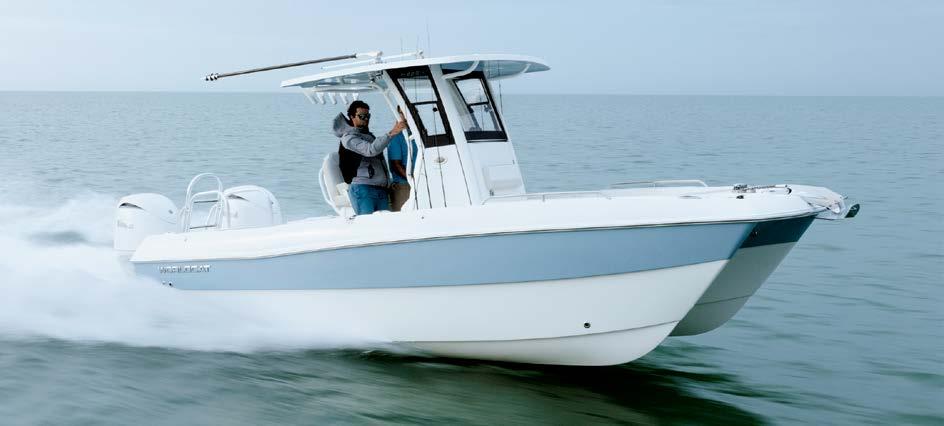

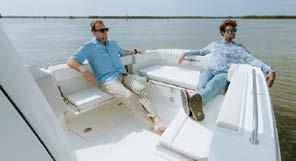

other places.
It all starts with the design, and World Cat’s sea-proven catamaran hull and ride — no matter what size — is all based on the same intention: To plan, engineer and build the best-performing boats in their class with operating capabilities in a wide variety of sea conditions.
“When designing the 235TE (Tournament Edition), we wanted to take it back to our roots to a fishing-forward model showcasing the innovation and comfort of a World Cat,” says Vice President of Sales and Marketing Chad Armstrong.
The 235TE is based on the company’s successful 235CC center console model. Starting up at the bow, there are fold-away jump seats and in-deck storage. The trolling motor pre-rig is standard and there are four gunwale-mounted rod/cup holders as well as stainless grabrails. The helm offers a fiberglass T-top with a rocket launcher and aft spreader lights, a flip-bolster leaning post with rocket launchers,
a tackle drawer, a 45-quart YETI cooler with seat cushion and a single Garmin GPSMAP 8612xsv 12-inch multi-touch chartplotter/sonar with 315 VHF. Thanks to two 60-gallon fuel tanks, you can stay out longer and explore farther.
On the stern are port and starboard in-sole fishboxes with overboard discharge, a 30-gallon livewell and insulated top-load boxes. Options include Yamaha 150-hp XSA2 with HelmMaster XL joystick or Mercury 150-hp XL power, a deck-mounted windlass and a GEMLUX outrigger system with 18-foot collapsible hybrid poles.
“The 235TE is stacked with standard amenities focused on family fishing," Armstrong says. "We also raised the gunnels and added additional bow and cockpit space."
The 23-foot World Cat 235TE is a standout in her class and deserves to be on your shortlist for a visit and sea trial.
SPECIFICATIONS
LOA: 22'7"
Beam: 8'6"
Draft: 9"
Transom Height: 25"
Dry Weight (w/ 2 x 150 engines): 5,275 lbs.
Fuel Capacity: 120 gals. (2 x 60 gals.)
Max Power: 300 hp
MSRP: Contact dealer WORLDCAT.COM
DEALERS SkipperBud’s SKIPPERBUDS.COM
 By Peter Frederiksen
By Peter Frederiksen

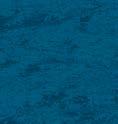


Peerless reputation and all you would expect from Tiara.

Walking down the dock heading toward the newest Tiara in the company’s 50-year history, there was no mistaking the yacht’s lineage. From bow to stern, the luxurious style and gorgeous sheer gleamed under the afternoon sun on the St. Lucie River in Stuart, Florida. The Axalta-painted Fog Grey hull and white gelcoated topside looked razor sharp. When I peered at the transom, which read EX 54, I recalled many new Tiaras I had tested over the years whose transoms were labeled Crown Jewel. More than a jewel, the new EX 54 is the whole store and everything in it.
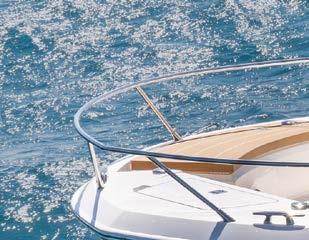


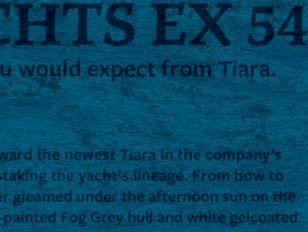
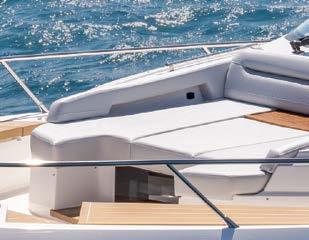
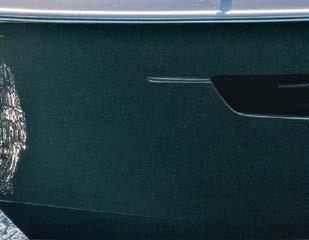
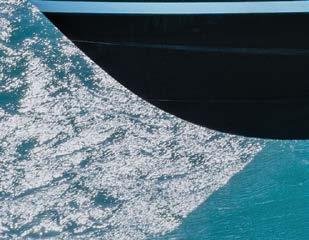


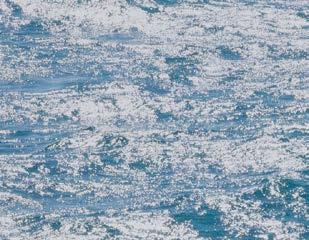


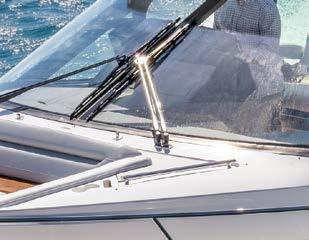


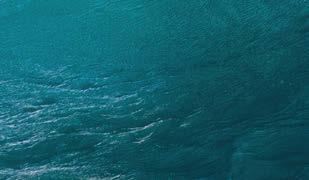
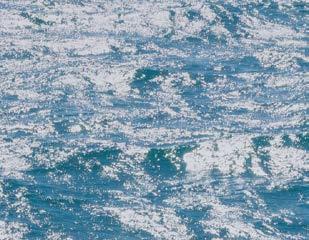


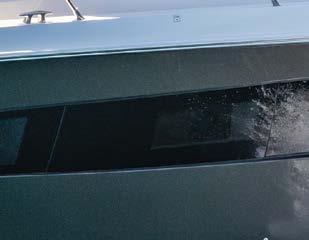

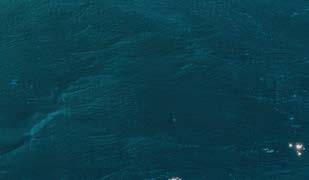
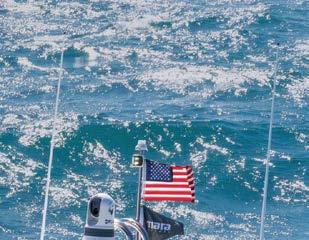
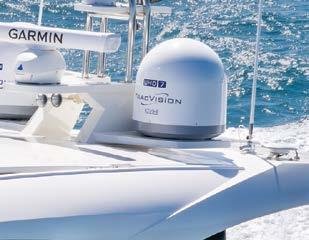
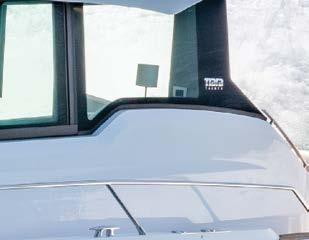



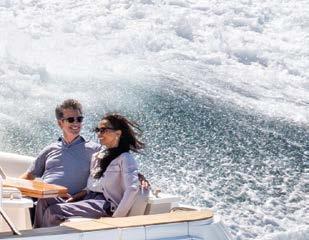
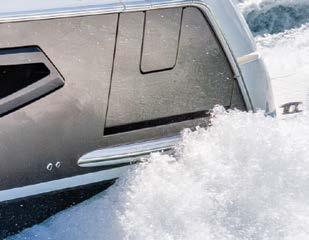



LOA (w/ std. swim platform): 54'3" Beam: 15'11" Draft: 3'8" Dry Weight: 48,400 lbs. Fuel Capacity: 650 gals. Water Capacity: 135 gals.






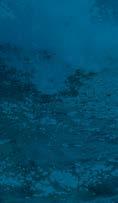




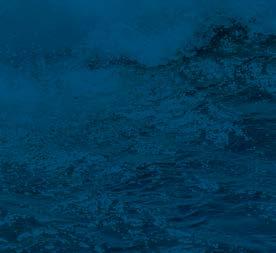
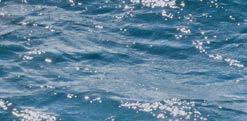
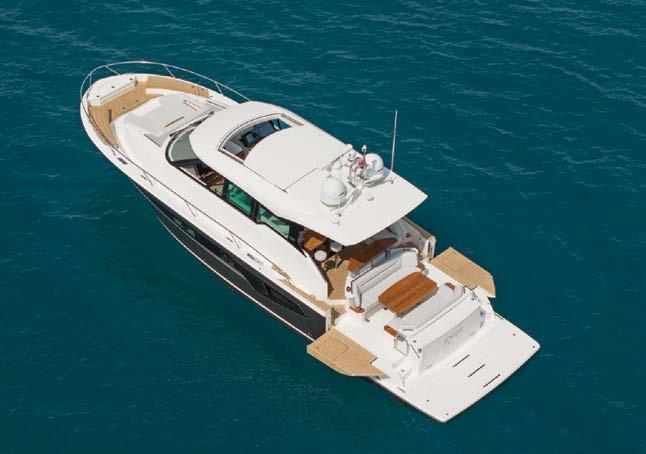
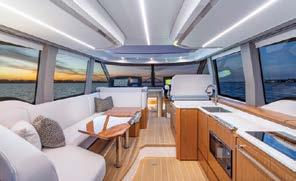

The cockpit alone proposes endless opportunities for the cruising fraternity starting with a choice of three distinctive modules. Our test boat, hull No. 1, featured the Lounge module, which includes forward- and aft-facing lounges separated by a drop-leaf teak table, polished stainless steel grabrails for secure moving about, as well as gated port and starboard molded steps to the 60-inch swim platform with recessed dinghy or PWC chocks and pad eyes. Our swim platform was the optional hydraulic version with its cleverly integrated and disappearing stairway. Either platform version provides electrically actuated access to trunk stowage below the module, along with a hot and cold shower, and raw and freshwater wash-down systems. An electric grill is handy yet recessed into the solid surface countertop abaft the forward-facing lounge along with a dual-voltage refrigerator, an optional ice maker and ample stowage. If fishing is more your lifestyle, the Adventure module adds different seating and available space rod holders, tackle drawers, an insulated cooler tub and a live baitwell. The Glass Patio module features a laminated glass bulkhead in the stern and available racks for bicycles, kayaks and other gear in the spacious trunk. Port and starboard hullside terraces with Herculan synthetic teak flooring add more room to move about in the cockpit, and each terrace includes an inward-opening boarding door — a smart answer for docking convenience, especially when bringing aboard groceries and sundry gear. Alfresco dining opportunities are encouraged with a fixed hi-gloss teak table with a pair of breakfast bar ottomans. A second intimate and inviting teak counter with a pair of bar stools is at the port bulkhead with a switch that operates a drop-down window to completely open the salon to the cockpit. To starboard, a cooler box can be equipped with an optional 3-cubic-foot refrigerator/freezer to keep your

outdoor guests refreshed without needing to enter the salon. A TV appears at the touch of a button from the fiberglass overhead. Sun and rain are easily addressed with the Makefast Marine powered sunshade. A large hatch in the Herculan sole provides access to the acoustically insulated machinery compartment with typical Tiara attention to detail, including an available Seakeeper 9 gyro stabilizer, a five-port oil changing system for the Volvo engines and the Onan 13.kW generator, and easy owner-operator maintenance points.
I especially liked the wide sidedecks with Tiara’s signature molded nonslip sole, and the waist-high stainless steel railing surrounding the deckhouse, which provides safe traveling fore and aft. A Lewmar windlass is standard and operates remotely with a handheld device, as well as from the helm. The fresh and raw-water faucets in the rode locker seal the deal to freshen the rode being retrieved, as well as offer a quick solution to washing the bow area. The forwardfacing lounge and table were also attractive features, but what caught my eyes were the stainless steel grabrails for passengers using the lounge while the boat was underway, and the port and starboard gunwale stowage compartments not just for fenders, lines and other loose gear, but also for the carbon fiber poles for the optional sunshade. A place for everything and everything in its place is a rule in the Tiara tradition I admire and subscribe to.
Detailed with lush teak joiner work and tasteful Chilewich wall covering with Ultraleather panels, the salon and helm area is a similar crowd-pleasing gathering and social area much like the cockpit. Immediately inside the sliding glass salon door is a comfortable lounge with an end table to port — an ideal spot to relax with a book, converse with other guests outside and inside, or watch the 43-inch television

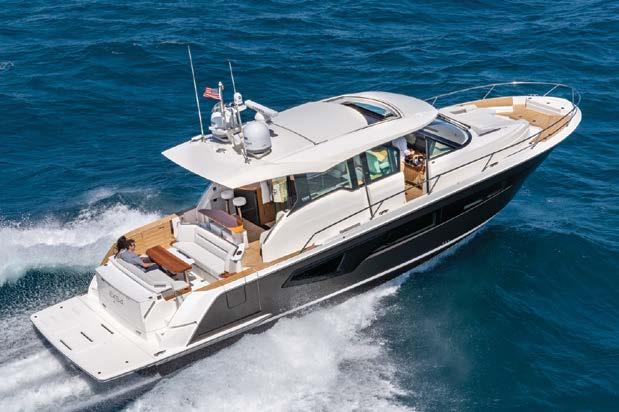
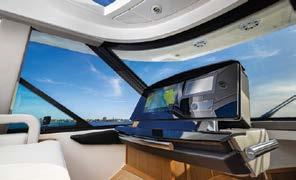
that rises from the teak joinery in the starboard galley. Forward to port is a hi-gloss teak dinner table that can convert into a berth should you have a guest reluctant to leave after dinner. The full-featured galley is built around a quartz countertop with a stainless steel under-mount sink, a microwave convection oven, a Kenyon electric cooktop and dual drawer refrigeration. Stowage is abundant throughout. Large tempered glass panels at the windshield, side windows and the glass sliding entrance door and bulkhead invite acres of daylight inside. For privacy, power blinds for the side windows and manual Duette blinds are provided. Herculan synthetic teak flooring throughout the salon is easy on the feet, grippy when wet, and wipes clean with a damp mop. A Webasto BlueCool V-Series air conditioning system blows 30,000 BTU of chilled air throughout the salon and galley, plus another 6,000 BTUs at the helm. The vents are deftly placed for thorough, quiet cooling while avoiding annoying breezy cold spots. Maintaining a comfortable temperature can be challenging with all that glass on hot, bright sunny days, but it was obvious Tiara’s engineering and design group nailed it here. For natural ventilation, a Webasto electrically actuated sunroof and a sliding pilothouse door bring the fresh breeze aboard.
The three-stateroom, two-head layout is generously proportioned to provide comfort and privacy and an abundance of natural lighting thanks to the hullside windows and ports. The full-beam mid-ship primary and the forward guest stateroom each offer queen berths with custom teak headboards and innerspring mattresses assuring a good night’s sleep. Each berth lifts to reveal lighted stowage compartments, while drawers and cedar-lined hanging lockers promise more than enough wardrobe room for a month’s worth of cruise wear. The primary has room for an optional washer and dryer — a good choice for long-distance travelers. Smart TVs are standard

in both staterooms: A 55-inch in the primary and a 32-inch in the forward. A starboard stateroom is outfitted with upper and lower berths. The primary has a private head and the guest staterooms share the second head; both heads have a fiberglass shower stall, vessel sinks and Dometic Vacuflush MSDs. A thoughtful feature in each stateroom is a built-in inductive cellphone charger.
Powered with twin Volvo IPS2 950 diesels rated at 725 hp apiece, the EX 54 hit a top speed of 33.7 knots on a smooth St. Lucie River with the Tiara test engineers aboard a couple of weeks before my sea trial. My test day saw five people aboard with similar loads of fuel, water and cruise gear, and topped out at 33.5 knots according to the Garmin GPS. A 2200 RPM throttle setting delivers 26.7 knots consuming 53.7 gph and a 290 nautical mile range. The Volvo Active Trim was used throughout our test, and although the water was calm, the visibility from the helm was excellent at every throttle setting standing at the helm or sitting in the Stidd helm seat. Equally impressive were sound levels that never exceeded 71 dBA even at full throttle, and five people carried on a conversation in the salon commenting about the lack of chatter from the engines. With the pilothouse door and the Webasto sunroof open, the water sliding past the hull was more vocal than the Volvos.
The helm station is noteworthy with its Volvo Glass Cockpit that integrates the full Garmin package of navigation electronics, the Volvo joystick, the Dynamic Positioning System and Assisted Docking, among other useful and safety-oriented features.
The team at Tiara has done a wonderful job with this new model. The Holland, Michigan manufacturer expects to build and deliver 12 to 18 EX 54 yachts in the coming year. It’s an exciting time to see what Tiara Yachts has to offer.



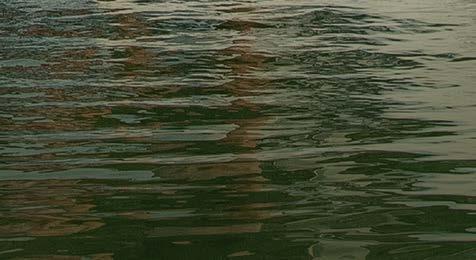
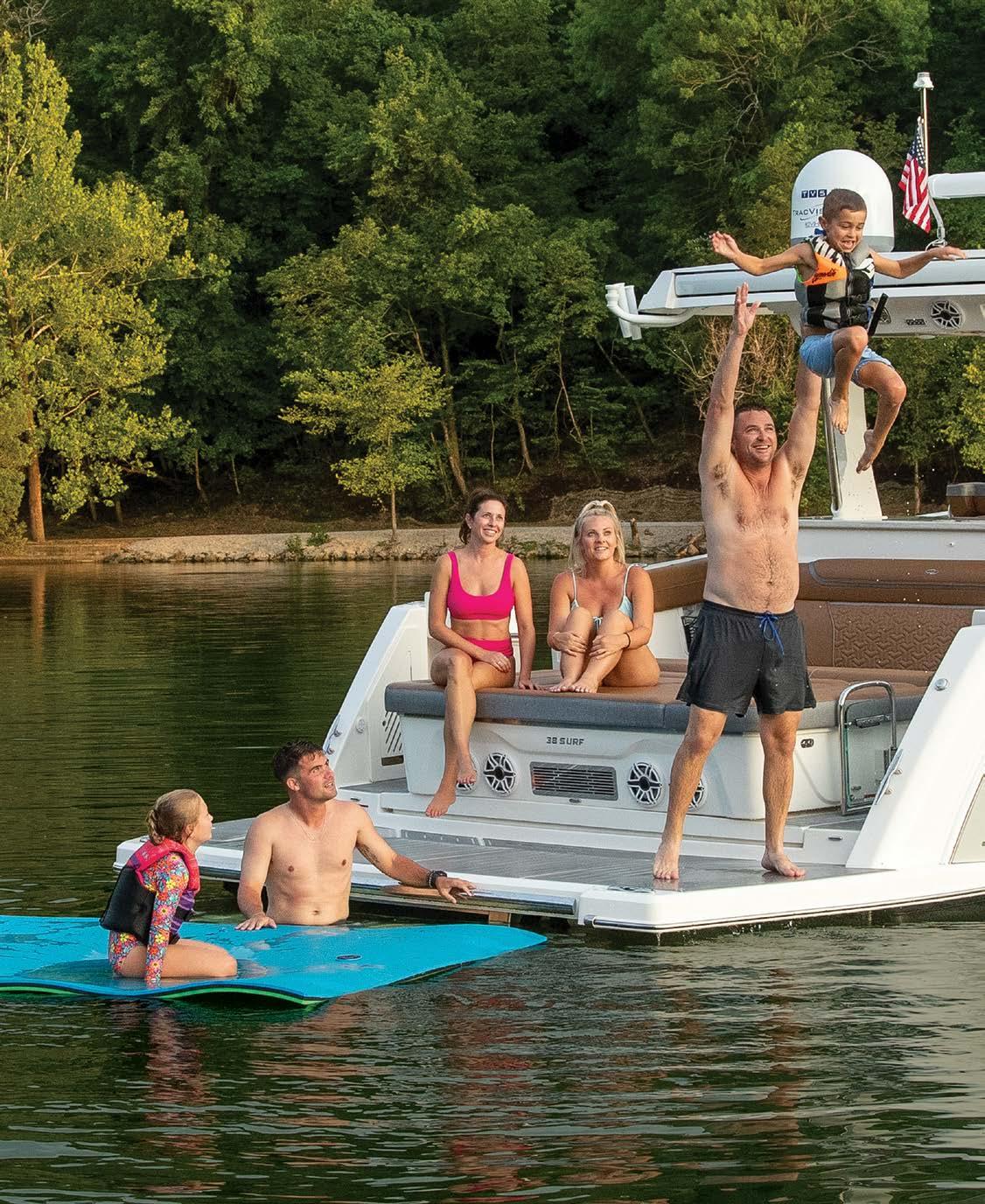
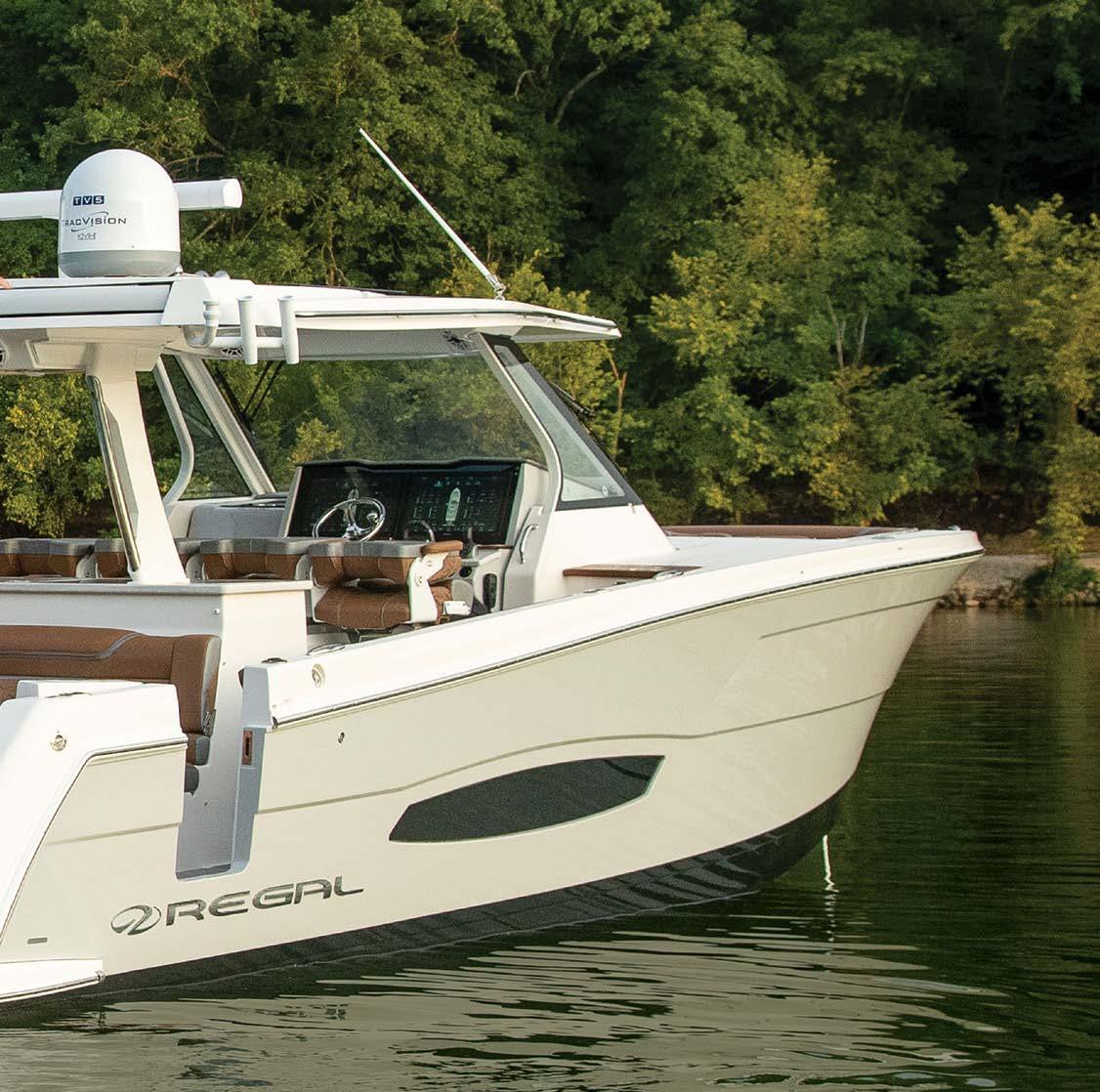
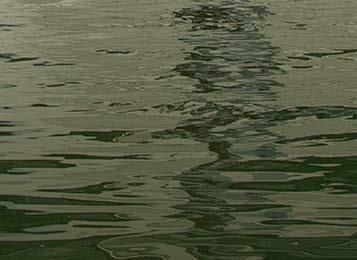

n 15 years of doing boat tests for magazines, this one remains unique. And that’s because my sea trial of the Regal 38 Surf almost didn’t happen, thanks to a very lazy Biscayne Bay manatee.
The boat was docked at the Venetian Marina just north of the 2024 Miami International Boat Show, which is apparently a hub for the local manatee population. One of the blubbery beasts had decided to take up residence right next to the props attached to the Regal’s powerful twin 380-hp Volvo Penta forward

drives. With official “manatee observers” nervously roaming the docks and beckoning us to stay put, the day looked to be in jeopardy. Luckily, our portly friend soon bobbed off to seagrass unseen, and the sea trial got underway. The Regal 38 Surf needs those mighty Volvos for good reason — it is billed as the largest surf boat in existence. And with that title, it’s got two roles to play: It needs to be nimble enough for a surfer’s needs, but also, with great size comes great responsibility.


The 38 Surf can’t just be a surf boat; it needs to do more, and it can. She works as a weekender, a gentleman’s angler, or just a fun, fast cruiser with lots of onboard space and a kicking sound system. Let’s dig in, shall we?
As I hopped aboard the Regal I landed in the spacious cockpit. Twin inward-opening dive doors to starboard and port rested on beefy hinges and will make for easy entry to and egress from the water for swimmers and divers. Convertible seating at the transom had a back support that shifted on a hinge to face forward or aft, so guests can either take part in the cockpit conversation or watch the surfer dance on the Regal’s wake out the back.
One thing that I found pleasantly surprising for a wakeboat was that the 38 Surf had two fully macerated and refrigerated fishboxes in the cockpit sole. I speak from experience saying there is nothing like fresh sushi after a good surf, and this boat has you covered in that regard. There was aft-facing seating for four situated amidships. Fold-down armrests here aided in comfort while dedicated stowage below for life jackets helped the Regal gain high marks for safety. Furthering that aim was a rear-facing camera integrated into the hardtop to watch the surfing action while at the helm, and extra lights for low-light setup to ensure everything is prepared properly for dawn patrol.
A notably chunky tow ring was built into the hardtop, solid as a rock. Regal also put high glass doors at both transom entrances, with the idea being to keep both pets and kids inside the boat. As a dog owner and father of two young children, this resonated with me.
Of course, the 38 Surf is, at its heart, a wakeboat, so fun is nearly as high on the list of priorities as safety. To that end, the boat is dotted with speakers and subwoofers nearly everywhere one looks, including four of them at the aft end of the transom so the surfer can hear every note.
Amidships there is what might best be described as a refreshment island that has a grill, sink, trash can, extra stowage and lots of counter space for meal prep. The island also has plenty of drawers for silverware, fish tackle and whatever else you need for your adventure. Another nice touch is that above the grill there is a separate MFD that allows the chef control over the lights, stereo system, swim platform and other features.
As the boat puttered out of the harbor and through the protected manatee area, I took some more time to acquaint myself with the layout. The 38 Surf is something of a hybrid center console/bowrider, and the bow lounge is quite a treat. Seating was comfortable, speakers and cupholders were plentiful, and the manatee observer we took with us from the docks seemed quite pleased to be taking in the views from a spot almost perfectly suited to his job.
I shortly crept down into the Regal’s accommodations level and was immediately impressed by the amount of space down there. You could ostensibly sleep four adults onboard, thanks to a queen-size berth in the forepeak and convertible twin berths amidships. You’d
have to be good friends, but it would work. One thing this boat has that you won’t see on every 40-footer is a dry head with a separate walk-in shower. That goes a long way for comfort, particularly with larger crowds. It’s a nod to Regal’s clear ambition to market the 38 Surf as something more than just a wakeboat.
As we neared the mouth of Government Cut, I heard the engines rev up and made my way to the helm. The seating there is four wide and very comfortable. Sightlines at slow speeds were good, and the boat has a camera to help the captain see over the bow when a surfer is on the wake.




SPECIFICATIONS
LOA: 39'2"
Beam: 11'11"
Draft (up/down): 2'9"/3'
Dry Weight: 19,400 lbs.
Fuel Capacity: 249 gals.
Base Power: 2 x Volvo V8 380 FWD EVC2 DP CAT joystick MSRP: Contact dealer REGALBOATS.COM
DEALERS
Basa’s Marine BASASMARINE.COM
Grand Bay Marine GRANDBAYMARINE.COM
South Shore Marine SOUTHSHOREMARINE.COM
�
WATCH THE VIDEO AT LAKELANDBOATING.COM
�
Super nimble handling that was an absolute blast to drive. The accommodations levels was legitimately usable for a group of people to stay overnight. The sound system thumps.
The 38’s sheer size means it throws off a wake that will take some getting used to, especially for beginner wakesurfers.
I took the wheel and pushed the throttles forward and we ripped off into the open Atlantic. The seas were gentle 1- to 2-footers so I felt comfortable dropping the hammer as I turned south out of the inlet. The Regal raced up to 38 knots all out, with acceleration that was smooth and responsive, all while maintaining an attitude that left for clean lines of sight. I dropped her back down to 31 knots where she burned 37 gph, and sliced her through slaloming S-turns and aggressive hardover loop-de-loops. The hull gripped the water’s surface like it was on a track, and I felt a smile peel wide across my face. It had been a while since I’d run a sea trial on a boat this athletic, and the sheer joy of it all was exhilarating.
The Regal guys had a surprise in store for me as well. I thought I was onboard with two sales reps (plus our manatee observer), but in actuality one of the “sales reps” was a professional wakesurfer. I relinquished the wheel to the real Regal rep who revved the boat to 12 knots, kicking off an eminently surfable-looking wake. I’ve never wakesurfed, but I do surf, and the wave reminded me of the famous point break Rincon in Santa Barbara, California, gently sloped and never-ending. And the surfer absolutely shredded it, carving hard turns, throwing spray off the top, dipping back down into the trough and then popping big airs. Oh, to be young again.
What you’re getting with the Regal 38 Surf is a boat that is rather unique in the marketplace. In fact, I can’t think of a boat that could reasonably claim to be competition. Where else could one do real fishing and proper overnights on a vessel that lets a wakesurfer absolutely rip behind it? I have to hand it to Regal, I was really impressed with this sea trial. It will be memorable for more than just a manatee.

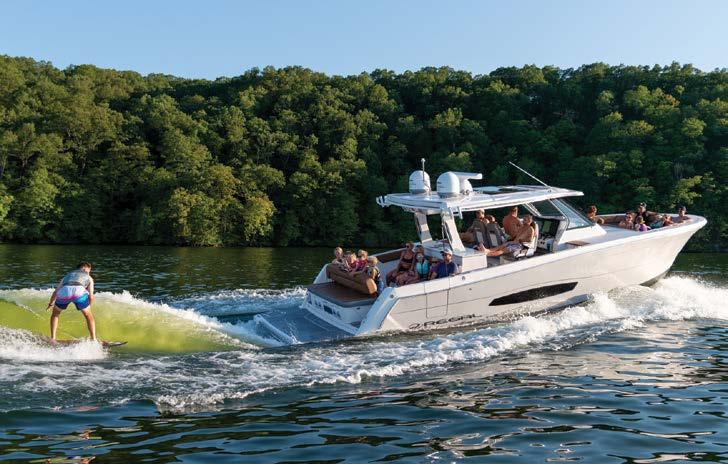
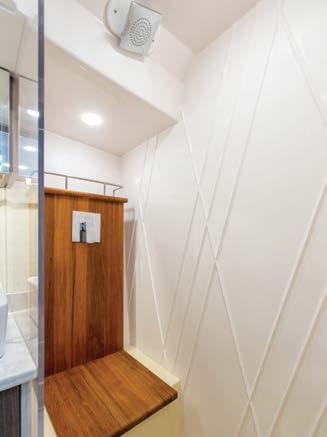
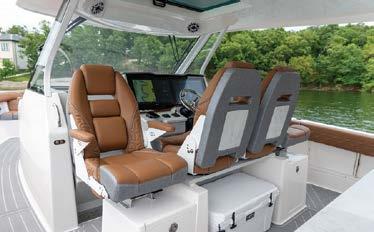
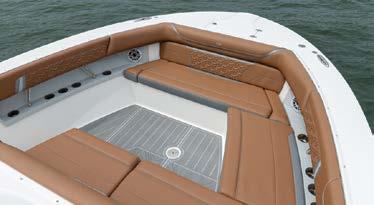
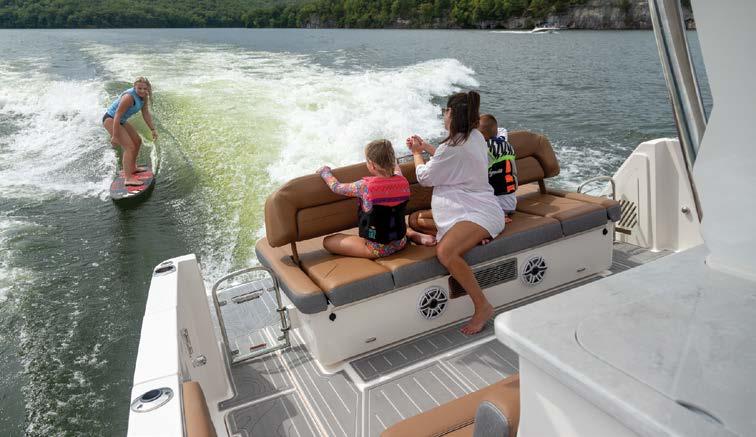
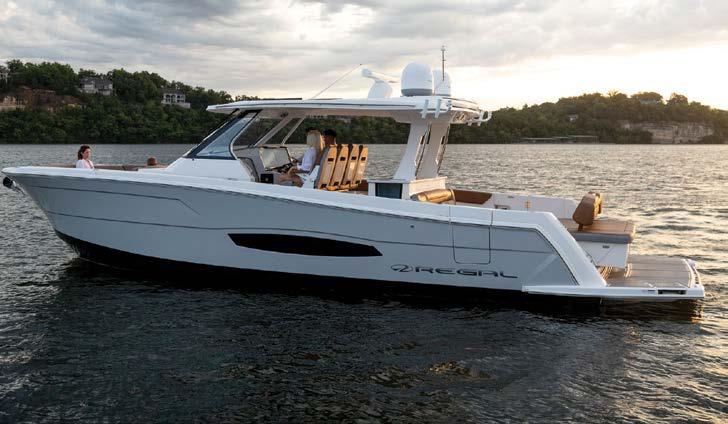

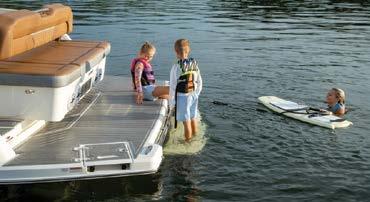
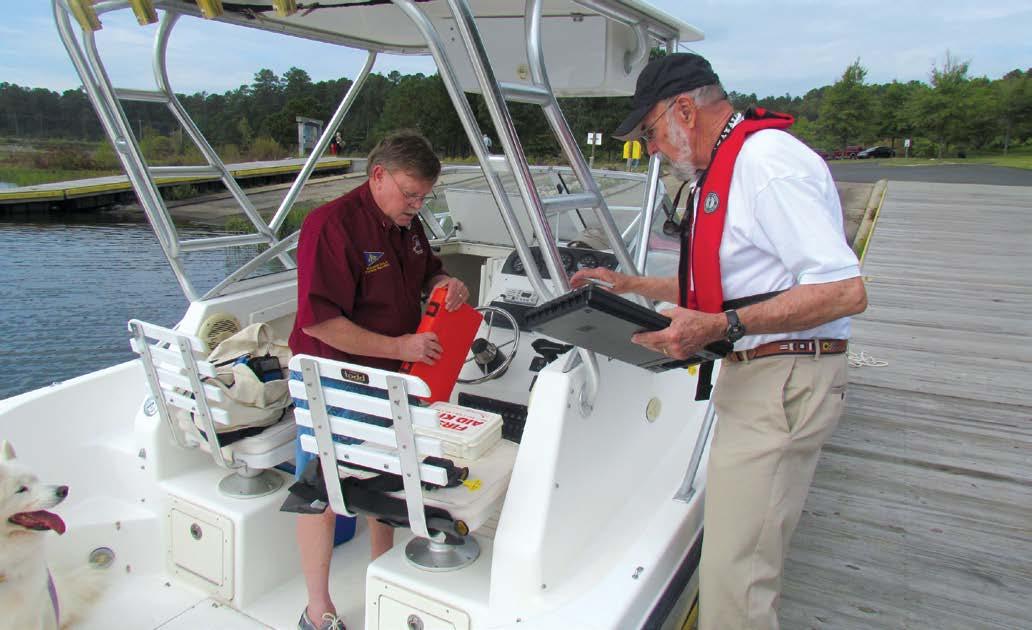
The United States Power Squadrons (USPS) was at a crossroads. It had an identity problem. While many had heard of the 110-year-old group, market research in 2022 revealed that a lot of people had no idea what exactly USPS is and does, says Director of Marketing Tammy Brown. That led to a further study that resulted in a recent name shift and logo change to become America’s Boating Club, though the U.S. Power Squadrons remains as the legal entity and continues to be part of what Brown describes as dual branding.
“When people say, ‘Who are you with?’ we say ‘America’s Boating Club/United
States Power Squadrons,’” Brown explains. “When you see us at an event, you’ll normally see both names in the same place It’s a lot to say… but it connects together and there’s a memory there [that] ‘They’re the people that teach boating instruction across the country.’”
The U.S. Power Squadrons was originally formed as a recreational boating organization in 1914 when representatives of multiple yacht clubs came together at the New York Yacht Club to establish this national group that was as much about camaraderie as recreational boating safety. Over time, the USPS took on various roles from
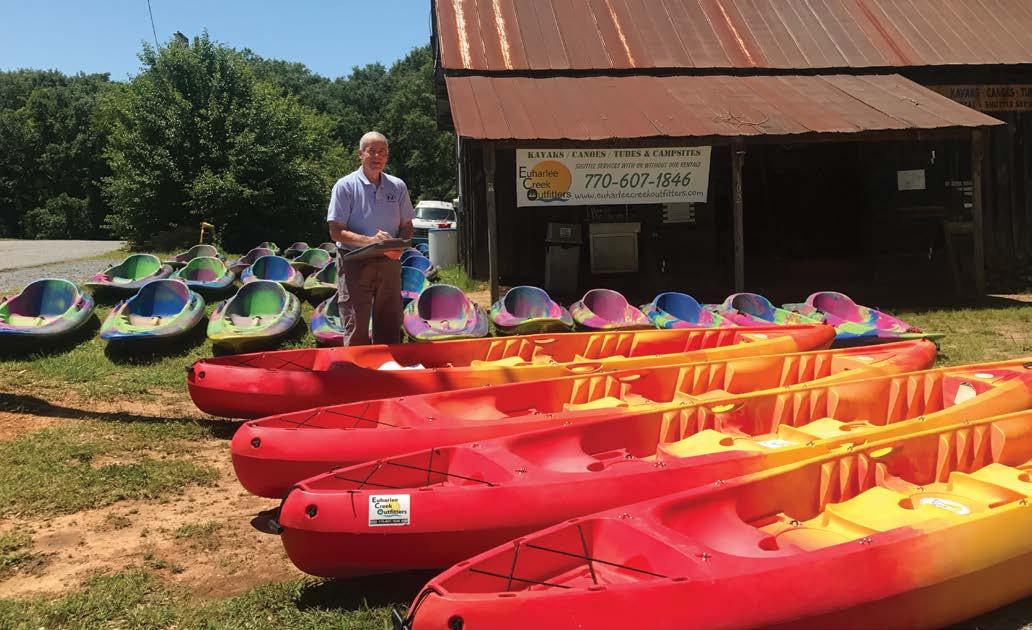
supporting war efforts to providing boater education — the latter being a key and expanding function today.
Right now, America’s Boating Club/U.S. Power Squadrons has about 20,000 members representing some 350 chapters (squadrons) across the U.S. That’s down from 25,000 a few years ago.
“Just like every organization that is membership-based, our trend is downward flowing,” Brown says. While boat ownership grew as the ultimate in social distancing during COVID, people have been returning to their pre-pandemic pastimes, she notes. Statistics from the U.S. Coast Guard show that in 2022 there were 11,770,383 registered recreational vessels across the United States — that’s a 1.6% decrease from the previous year.
The goal now is to reverse the membership decline. To appeal to new members from all sectors of the boating public (including motorized, nonmotorized and human-powered craft like kayaks and canoes) the organization is working on building awareness of the fellowship, education and safety services that have attracted generations of families.
“When we started, we were known for larger vessels, 40 feet and up,” Brown says. “Now our focus is really on recruiting that 35- to 55-year-old member [whose] boats are trailered because that’s where most of the boating population is, especially the new boaters. They’re trailering their boats to the lakes and getting back out of the water and trailering home. That’s where we kind of laser-focus our membership recruitment.”
People are also buying smaller boats. Throw in anglers, who Brown says “don’t really consider themselves boaters” and there’s another market to tap.
The 2024 president of America’s Boating Club/ United States Power Squadrons, Ralph Bernard, has had a lifelong association with the organization. After serving in the U.S. Navy during World War II, his dad came home and bought a surplus barge that had been used to transport admirals ashore during the war. His father
joined the club in the 1960s, though his mother had to wait until women became eligible for membership in 1982.
Living in New Jersey, the family’s recreational life very much revolved around boating. That was the case whether they were cruising on the Chesapeake Bay or the Great Egg Harbor River where Bernard, now a retired state trooper, still lives. His family participated in multiple club events. They even went to the 1964 World’s Fair by boat from their home in South Jersey.
“It was always if mom and dad went, we went too, until we went off to college,” Bernard says. “We were as involved as they were. We did the work, we cleaned up, prepared for social events and we took courses.”
Bernard was 12 when he completed a 10-week USPS boating safety course.
“I had no idea how to chart a course or what dead reckoning is,” he says. “It made me a whole lot more confident.”
Upon returning from serving in the U.S. Air Force in 1979, Bernard joined USPS.
“You became part of the organization — either teaching courses or taking courses, participating in social events,” he says. “We were very involved all the time.”
Both of his grown daughters are now boat owners and members. Two grandsons, ages 19 and 20, are also members and capable boaters who have earned their first “merit marks” for service to the organization. Bernard also has two granddaughters — one’s too young to be a member yet, but he knows she will when the time comes.
As president, Bernard is focused on growing membership to expand the America’s Boating Club/U.S. Power Squadrons educational programming. The organization provides an introductory class called America’s Boating Course that Bernard and Brown say goes far beyond the minimum most states accept.
“Many states require and offer basic boating education courses,” notes Brown, “but we believe America’s Boating Course offers a more comprehensive educational experience for new and experienced boaters.”




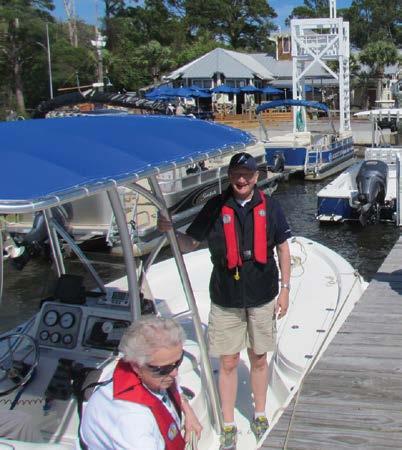
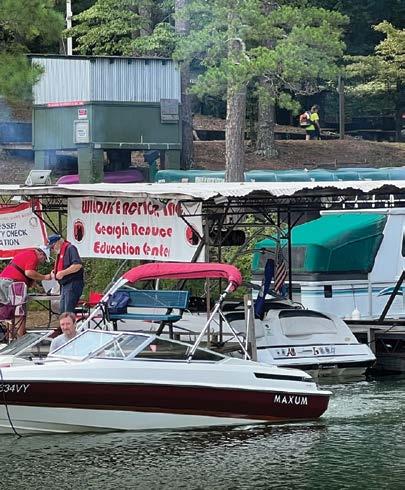
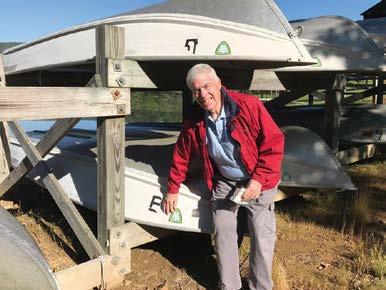


Covering such elements as nautical terms, safety equipment, how to fuel, casting off and operating underway, navigation rules, signals, anchoring, trailering, knots and lines, and a whole lot more, “not only does it keep things safer, but it makes people feel more confident when operating a vessel,” Bernard says. “Your chances of having an accident are curtailed greatly. It also makes a better experience on the water.”
Additional separate courses focus on topics such as weather, marine navigation and boat handling. Boaters can enhance their skills and knowledge with seminars in technology (radio, GPS and cameras, for example), using nautical charts, paddling, docking, anchoring, handling onboard emergencies and more. There are also webinars on themes that include ocean currents and computer navigation, personal watercraft and living aboard while cruising.
Courses are written and taught by volunteers — all the more reason to build membership, Bernard says.
“The less volunteers we have, the less personnel and resources we have, and it curtails what we can do,” he notes. “If we can grow the organization and get more volunteers, it makes the organization more viable and healthier, but it also provides the community with a better service because we have those extra resources.”
The club provides free annual vessel safety checks as part of a U.S. Coast Guard program that is also available through the U.S. Coast Guard Auxiliary. At a boater’s request, volunteer instructors will board a vessel and conduct an inspection, identifying deficiencies the owner can address.
“We make a date to come back and board your vessel again, and once you pass, you get a sticker,” Brown says, explaining that displaying the emblem signals to the U.S. Coast Guard that the craft has met safety requirements.
Besides participating in social outings and gatherings, the regional squadrons tend to get involved in community service and support civic causes. Members are also eligible for a variety of discounts, including about 40% off boat insurance, Brown adds.
The main source of revenue for America’s Boating Club/U.S. Power Squadrons is from membership dues. The Coast Guard Foundation also provides annual grants that are sometimes in the several million dollar range and help fund the club’s educational efforts including a Boat Life 365 program that features various campaigns designed to promote safety.
Dave Fuller, an avid boater and volunteer with the U.S. Coast Guard Auxiliary currently serving as its national director of education, became a U.S. Power Squadrons member in 2010. He says that while the Coast Guard Auxiliary is also focused on education, it mainly provides entry-level curriculum when it comes to the public.
“At the higher than entry-level course, we start diverging into Coast Guard-specific training that the average boater is not going to get into (like) search and rescues,” he explains.
That makes America’s Boating Club/U.S. Power Squadrons advanced courses and other educational resources all the more important, he says.
“You have to be educated… you need to know ‘Do I need to stop, slow down, pass on the right or left of this guy? What actions do I have to take to make sure I don’t run into another person?’” Fuller says. “And there’s a lot of other things: ‘What safety equipment do I need, what is legally required?’”
He cites instances of boaters carrying life jackets that are inappropriate for the setting and type of use. People need to know what to do if there’s a fire. And while a vessel may comply with the basics when it comes to equipment onboard, there are other items boaters should know about to enhance their safety.
All are examples of things they can learn in the club’s classes.
“[The U.S. Power Squadrons] has been a leader for well over 100 years,” Fuller says. “It’s an organization that is focused on boating safety and has been since its inception. It’s got a great legacy.”
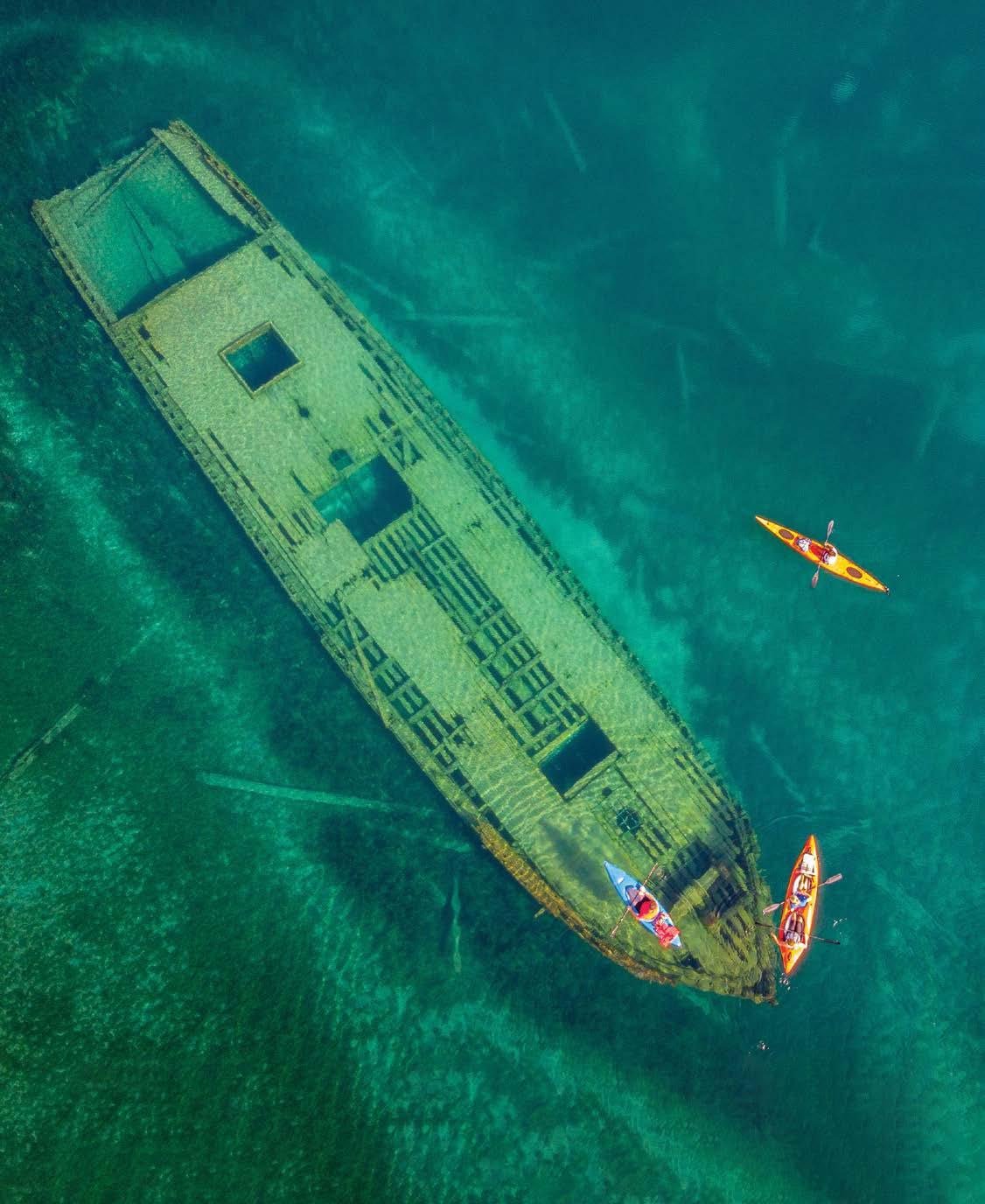
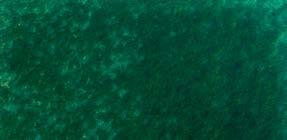


 By Craig Ritchie
By Craig Ritchie

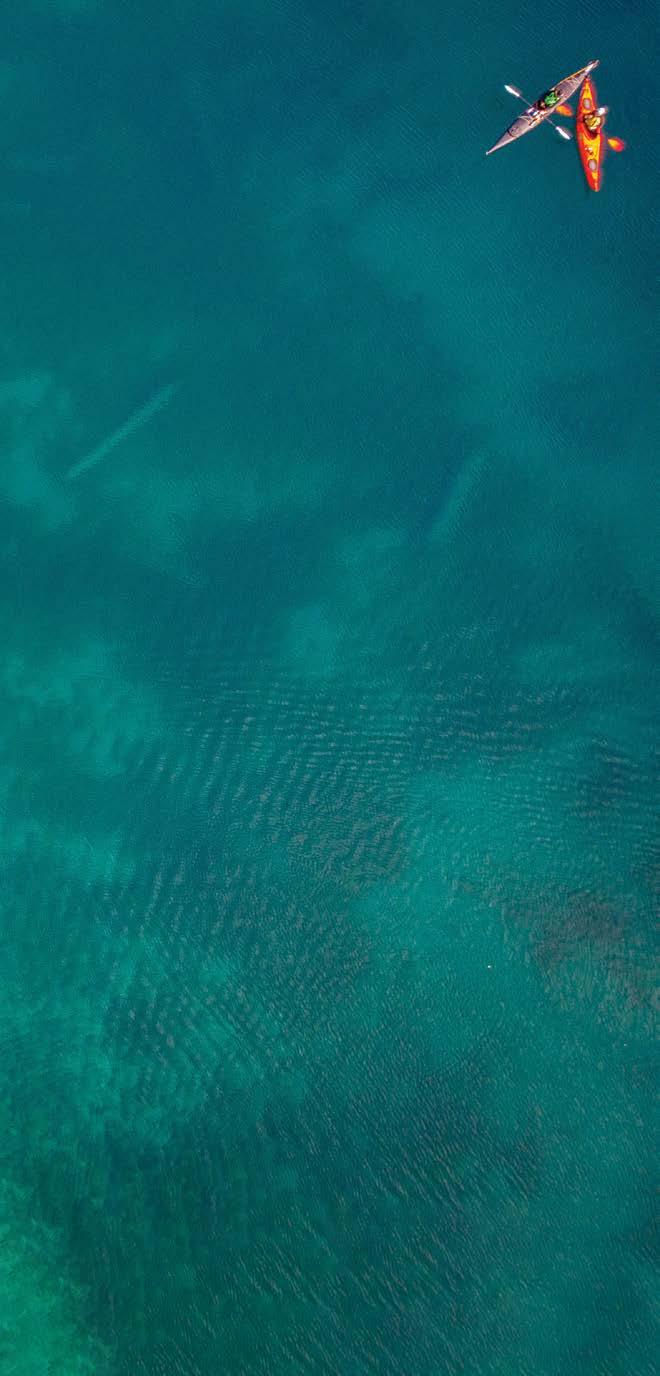

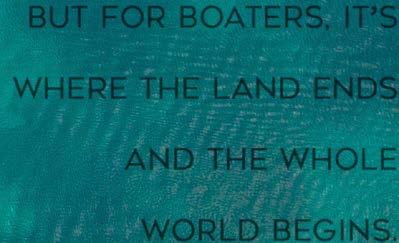
Perched at the tip of Ontario ’ s Bruce Peninsula, Tobermory might signal the end of the road for motorists, but for boaters, it ’ s where the land ends and the whole world begins.
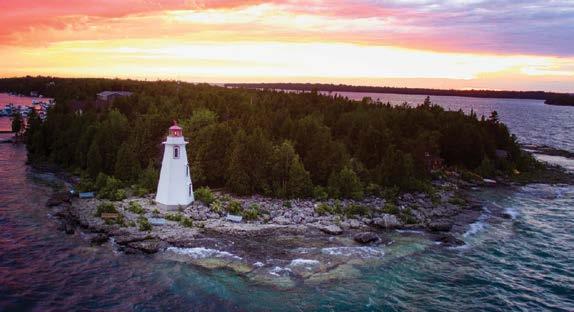
As a little kid growing up in southern Ontario, it was hard to not feel an affinity for the beautiful village of Tobermory, jutting into Lake Huron at the tip of the Bruce Peninsula. This was the end of the road — literally — the place where the cars either turned around or gave up the pavement for a spot on the giant Chi-Cheemaun car ferry that would take them the rest of the way to Manitoulin Island.
As befitting the end of the road, Tobermory was a wild place, its bare granite outcrops, weathered pines and Group of Seven natural beauty representing a sharp contrast to the manicured parks and lawns back home in Toronto, nearly four hours to the south. And there were the old shipwrecks, some even visible from shore! But more than anything else, it was the sense of being surrounded by water on three sides that gave Tobermory its incredible mystique. With the open waters of Lake Huron to the west, Georgian Bay to the east and Manitoulin Island hidden somewhere over the horizon as you looked toward the north, to my adolescent mind this wasn’t so much the end of the road as the beginning of the world.
It still feels that way today.
From its snug perch overlooking Lake Huron’s gin-clear waters, Tobermory is a pretty community of about 4,000 full-time residents — a figure that swells to three times that number in the summer when the seasonal cottagers arrive. For residents and visitors alike, life centers around Tobermory’s two outstanding natural harbors. The village sits on a small peninsula of its own, sandwiched between the Big Tub Harbour to the north and the Little Tub Harbour to the south. Little Tub is the more commercial of the two, being now more or less surrounded by the present-day village.
Sweepstakes in Big Tub Harbour Big Tub Lighthouse
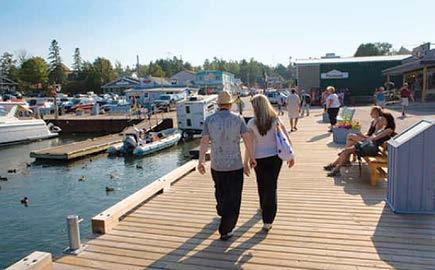
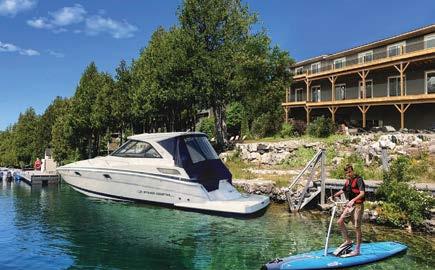
Where many Great Lakes settlements can trace their roots back hundreds of years, Tobermory is a relative newcomer. Native peoples and early commercial fishermen had put up shacks along its protected shores for years, with the fishermen even erecting a lighthouse to mark the tip of land at the entry to the Big Tub. But the site’s remote location and rocky terrain kept Tobermory off the grid and accessible only by boat until 1869. That’s when land surveyor Charles Rankin arrived, charged with mapping a roadway through the rock and brush to connect Tobermory with Owen Sound, some 60 miles to the south.
Following several weeks of “the most troubling explorations I have ever met with” Rankin completed his task, and the first groups of settlers began to arrive in Tobermory a year or two later. Many of these early pioneers found the granite landscape too difficult to work and simply gave up, abandoning their farms. That hasn’t changed, and the Bruce Peninsula remains sparsely populated to this day with most residents either working in the local tourism industry or commuting to jobs in Owen Sound, Southampton or other communities to the south along Rankin’s Road — today better known as Highway 6.
For visiting boaters, however, the wild landscapes and crystal clear waters are the main attractions, providing a rare opportunity to enjoy the northern lakes in their pristine, untouched beauty.
Situated on the end of a peninsula that juts some 60 miles into the lake, Tobermory is easy enough to find, whether you arrive by car (keep driving north until your feet get wet) or by boat (land ho!). Its position at the northern tip of the Bruce Peninsula once earned Tobermory the unfortunate moniker of Shipwreck Capital of the Great Lakes due to its exposure to almost any winds, relatively few lighthouses and numerous unmarked islands and shoals. Thankfully, modern weather forecasting and charting make navigating the area a piece of cake today.
Approaching from Lake Huron, the best route into Tobermory is to pick up the Devil Island Channel at Cape Hurd, a little over three miles from town, and simply follow its well-buoyed path. If you’re arriving from Manitoulin Island, the North Channel or from Georgian Bay to the east, navigate south of Flowerpot Island to avoid its many shoals before heading straight into town. A newer, red-topped white lighthouse marks the mouth of Big Tub Harbour, with additional buoys leading southeast to Little Tub.
Regardless of which route you follow, you’ll want to keep an eye out for the 365-foot, 7,000-ton car ferry MS Chi-Cheemaun (Ojibwe for “big canoe”) as you approach the town. The terminal sits on the shore between the Big and Little Tub Harbours, and the big boat always has the right-of-way.
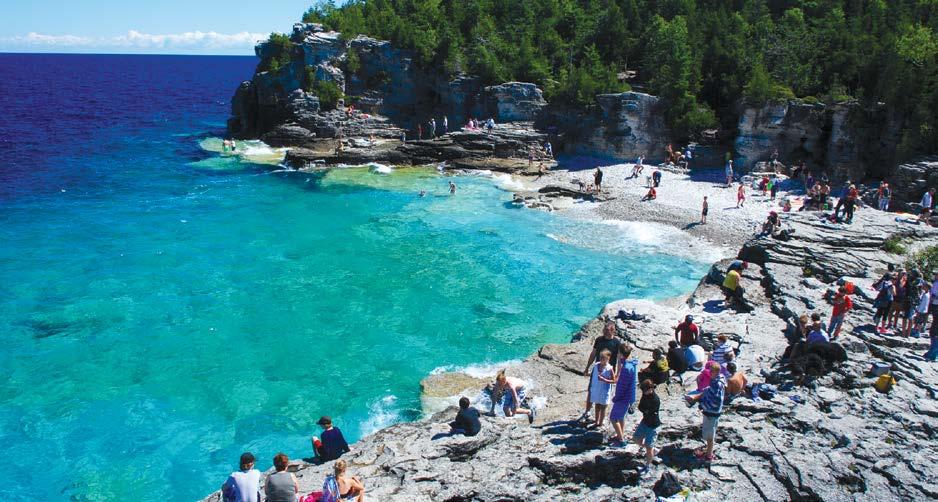
Most of Tobermory’s main attractions are most conveniently accessed from Little Tub Harbour, so point your bow there. That’s also where you’ll find the town docks, the fuel dock and the pump-out dock. Municipal guest slips line the harbor’s southern side opposite the ferry terminal, with space for about 50 transient boats; call ahead on VHF 68 or head to the well-marked fuel dock for a slip assignment.
While it’s not quite as convenient to the town’s amenities, mooring in Big Tub Harbour can be a lot quieter and a more peaceful option, particularly on busy summer weekends. Big Tub Harbour Resort, located on the north side of the harbor, has space for about 20 transient boats; call ahead on VHF 68 to secure a spot.
Let ’s get acquainted
Once you’ve tied up and settled in, you’ll probably want to look around a bit and stretch those legs after a day or two on the boat.
The horseshoe-shaped village surrounds Little Tub Harbour, making it easy to navigate and a pleasant stroll at any time of day. As you wander, you’ll notice a series of historic plaques here and there, which provide fascinating details on significant sites related to the town’s fishing, lumbering and shipping heritage.
On the southeast side of Little Tub Harbour you’ll spot a curious-looking cairn, which marks the northern terminus of the Bruce Trail, one of Canada’s most popular hiking routes. Established in the 1960s, the Bruce Trail meanders south and east along the Niagara Escarpment, passing through pristine Carolinian forest and open farmlands for more than 550 miles before reaching its southern terminus at the Niagara River near Buffalo, New York. If you’re looking to stretch your legs, and we mean really stretch your legs, Tobermory has you covered.
For a nice wander that stays a lot closer to the boat, take a toddle up Bay Street, which follows the southeast side of Little Tub Harbour. There you’ll find a range of restaurants, pubs, shops, an art gallery and basic provisions, including a grocery and a liquor store.

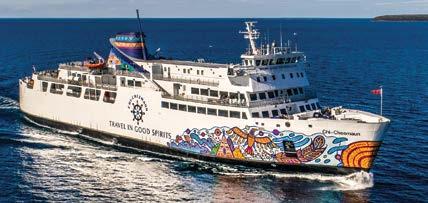
The car and passenger ferry Chi-Cheemaun runs a regular route linking Tobermory and South Baymouth on Manitoulin Island from mid-May to mid-October. It’s also the third-largest passenger ship sailing the Great Lakes, after the expedition cruise liner Viking Octantis and SS Badger.
A trip to Manitoulin aboard Chi-Cheemaun is a long-standing Great Lakes tradition. Built in 1974, the vessel has a capacity of 648 passengers and 143 vehicles, including room for buses and transport trucks. Chi-Cheemaun makes the 25-mile trip to South Baymouth in a little under two hours, crossing three times each day during peak season, and twice a day during May, June, September and October. For schedules, fares and details call 519-376-8740 or visit ONTARIOFERRIES.COM/MS-CHI-CHEEMAUN.
For a small village, Tobermory is served by an impressive range of places to eat, ranging from brew pubs to breakfast spots to bakeries to full sit-down restaurants. Fish and chips featuring locally caught whitefish is a staple that’s available everywhere and universally delicious. Craigie’s Harbourview Restaurant, the Crowsnest Pub and Grille, and Shipwreck Lee’s are popular favorites, while the Tobermory Brewing Co. serves up tasty fare with a revolving menu of craft beers. Prefer Mexican fare? Then make your way to Tacomory (pun very much intended) for great Mexican grub, food truck style. There’s also the Little Tub Bakery — just follow the irresistible aroma of fresh bread and you’ll spot it soon enough.
After you’ve snarfed down some whitefish why not follow with a tasty desert? Beavertails is a Tobermory
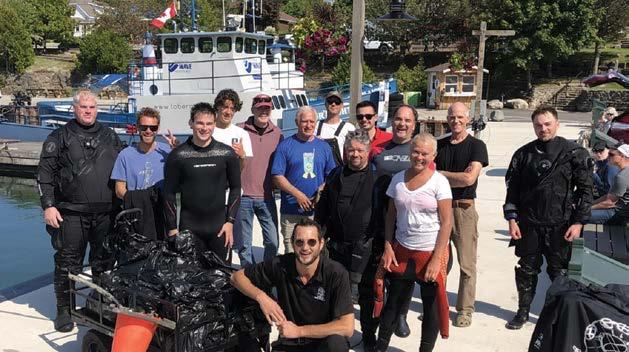
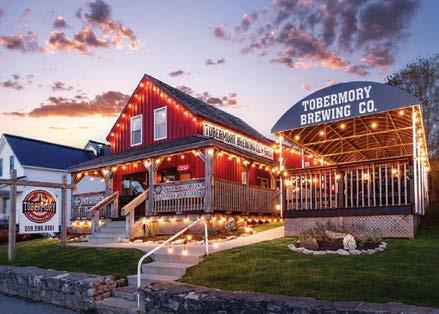
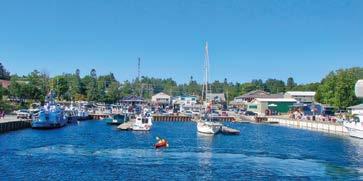
■ Little Tub Harbour
519-596-2731, 519-375-6033, or VHF 68 EXPLORETHEBRUCE.COM/PLACE/TOBERMORYHARBOUR-MARINA
Little Tub Harbour offers seasonal, monthly and transient slips with 30- and 50-amp electrical services on both finger docks and the main wharf, accommodating vessels up to 125 feet. A large fueling dock offers ethanol-free gasoline and ultra-low sulfur diesel. Other features include a launch ramp, washrooms, showers, pump-outs, Wi-Fi, a mast crane for sailboats and outdoor winter storage.
■ Big Tub Harbour Resort
519-596-2219, or VHF 68 BIGTUBRESORT.CA
Big Tub Harbour is a little farther from the town’s shops and restaurants, but it’s also a bit quieter and more secluded. Transient slips with or without power are available.
institution that’s well known for its remarkable fried dough pastries shaped like, well, a beaver’s tail. Or opt for ice cream at Ice Cream and Treats. Either way, you can’t go wrong. Tobermory may not be a particularly large village, but rest assured you’re not going home hungry.
Wandering the town reveals an enticing array of shops to browse, including the Hummingbird House, Golden Gallery, Georgian Bay Soapworks and the Net Shed for gifts and décor items, along with the Mariner Chart Shop for anything nautical. Pop into Reader’s Haven to pick up a few books for the boat, or check out Verna’s and the Blue Heron for clothing and nick-nacks.
Nearby, Diver’s Den is the bustling hub serving the scuba and snorkel set, who come from all around the world each summer to visit Tobermory’s wrecks.
With its unusually clear waters, unique underwater geological formations and more than two dozen shipwrecks within sight of town, Tobermory is globally recognized as a diver’s paradise. But you don’t even have to leave town to see shipwrecks, as a few are even visible from shore. Glass-bottom boats depart from Little Tub Harbour daily offering tours of the local area including multiple shallow water wrecks, allowing passengers to enjoy a close-up view of some of the most interesting ships without ever getting their feet wet.
Or, rent a kayak or stand-up paddleboard to explore at your own pace. Tobermory Cruise Line rents both kayaks and SUPs for visitors who prefer to chart their own course — and get some good upper body exercise — while enjoying the local area.
One of the most popular wrecks lies at the extreme western end of Big Tub Harbour. The Sweepstakes, a 19th-century, 120-foot coal schooner, came to rest on the bottom of the harbor in 1885 after running aground on a reef near Cove Island. Freed and towed to Big Tub Harbour for repairs, the vessel continued taking on water as the owners and insurance companies argued over the repair costs. The ship ultimately sank and, given the added salvage costs, was subsequently written off. Today, the Sweepstakes is visible in barely 20 feet of water, making it a favorite of swimmers, snorkelers and scuba divers alike.
Forgot your swim fins? The Diver’s Den offers two-hour guided snorkel trips with all gear supplied. Apart from the Sweepstakes, the Diver’s Den also leads guided snorkel trips to other nearby wrecks, including the Charles P. Minch with its visible steering wheel in 20 feet of water, and the W. L. Wetmore with its intact boiler, propeller, anchor and chains.
Just off the bow of Sweepstakes, you’ll find yet another popular Tobermory wreck. The City of Grand Rapids is super easy to spot, since at normal water levels a good chunk of it still pokes above the surface. The double-decked package steamer ran a regular route to Manitoulin Island for years, until catching fire at the dock in Tobermory one evening in 1907. A tug dragged the burning vessel into open water and cut it loose, only to have the prevailing wind push it back into port, where it drifted the length of Big Tub Harbour until bottoming out next to the Sweepstakes. It burned to the waterline and its lower hull remains there today.
To truly appreciate Tobermory’s underwater history, make a point of visiting Fathom Five National Marine Park, located a short walk east of Little Tub Harbour. Established in 1987, Fathom Five is the first national marine park in Canada, with most of it located under the lake’s surface. Created to protect shipwrecks and conserve freshwater ecosystems, the park includes 20 islands that provide critical habitat for a wide range of plants and animals, including the monarch butterfly, the
■ Blue Heron Cruises
855-596-2999
CRUISETOBERMORY.COM
■ Bruce Anchor Cruises
519-596-2555
BRUCEANCHOR.COM
■ Bruce Peninsula National Park
BIT.LY/3VRYSMO
■ Explore The Bruce EXPLORETHEBRUCE.COM
■ Fathom Five National Marine Park
BIT.LY/4AYYOON
■ Nautical Mind
416-203-1163
NAUTICALMIND.COM
■ Ontario Tourism DESTINATIONONTARIO.COM
■ St. Edmunds Bruce Peninsula Museum 519-373-7032
FACEBOOK.COM/ STEDMUNDSMUSEUM
■ The Diver’s Den 519-596-2363
DIVERSDEN.CA
■ Tobermory Cruise Line 519-596-2626
TOBERMORY
CRUISELINE.COM
■ Visit Tobermory VISITTOBERMORY.CA
eastern ribbon snake, the eastern whip-poor-will, and several rare ferns and orchids. One of the islands, Flowerpot Island, is noted for its namesake flowerpot stacks of sedimentary rock that stand a short distance from the island itself.
Most Great Lakes ports of call would consider themselves very lucky to have a prominent national park situated nearby. Tobermory has two of them.
A short distance farther south and abutting Fathom Five, Bruce Peninsula National Park overlooks Georgian Bay in dramatic fashion, with sheer cliffs and distinctive landmarks attracting visitors with cameras from all over the map. One of the largest protected areas in southern Ontario, Bruce Peninsula National Park forms the core of UNESCO’s Niagara Escarpment World Biosphere Reserve. Multiple hiking trails provide a great opportunity to stretch those legs after a long boat ride.
Two of the most popular spots in Bruce Peninsula National Park are The Grotto — a water-level cave that extends deep into the limestone cliff — and Indian Head Cove, a delightful inlet with a clean limestone bottom yielding bright turquoise waters that look a lot more South Pacific than Great Lakes. It’s a stunning sight, even on a cloudy day.
Not far from the park entrance is the St. Edmunds and Peninsula Museum, which offers an interesting look back at Tobermory’s early days. The site includes a restored 1875 log cabin, a 19th-century schoolhouse and a range of artifacts that provide detailed insight into the daily lives of early settlers in the region and the difficulties of survival in a remote and comparatively inaccessible environment.
Relaxing back at the boat after a long day of exploring, it’s easy to appreciate today’s comforts and conveniences, including the wonders of modern nav charts and weather forecasting. And that’s exactly why Tobermory ranks so high as a port of call on every Great Lakes mariner’s bucket list. With its extensive maritime heritage, stunning natural beauty and thoroughly modern amenities for visiting boaters, there really is something here for everyone. After all, it’s where the road ends and the whole world begins.
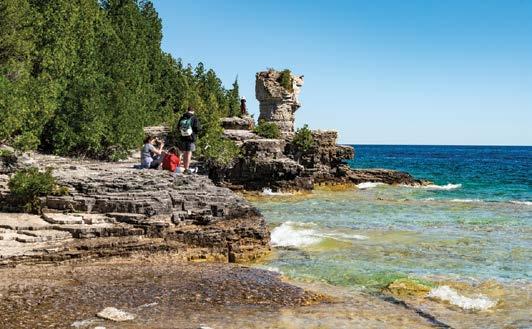

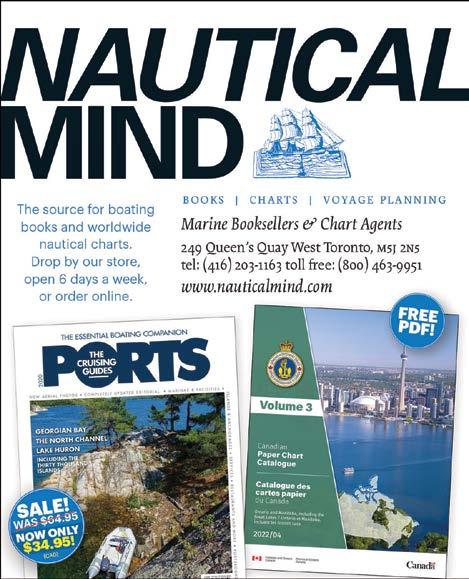


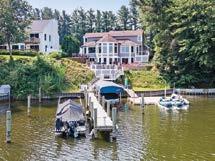
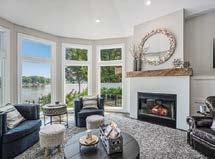

ADDRESS
18941 N. Fruitport Rd, Spring Lake, MI 49456
SPECS
Bedrooms: 5
Baths: 4
Square Footage: 2,835 (above grade); 4,585 (finished)
Acreage: 0.42
Shoreline: 96 feet
CONTACT
Sandi Gentry
RE/MAX Lakeshore
616-935-1150
SANDIGENTRY.COM
ituated on 96 feet of waterfrontage along Michigan’s Spring Lake, this five-bed, four-bath home is made for soaking up life on the lake.
“This custom-designed and built home offers a lifestyle of ease and elegance, boasting an array of extra amenities to enhance your living experience,” says the listing offered by Sandi Gentry of RE/MAX Lakeshore.
Gorgeous lake and sunset views can be enjoyed from nearly every room in the house, while the large outdoor patio features a natural gas fireplace and plenty of space to sit back and relax on summer evenings. A professionally landscaped terraced yard, a steel seawall and a viewing deck enhance the waterfront amenities, and the 70-foot dock with electric provides all the docking and watersports space you need.
Indoors, large windows and cathedral ceilings in the living area provide an open, light-filled space to relax, with a gas log fireplace to cozy up to during the colder months. The spacious kitchen features custom
cabinetry, granite countertops and professional-grade appliances. Escape to the main floor primary suite, where a luxurious ensuite features dual vanities, a Japanese soaking tub, a walk-in shower with dual shower heads and a private deck.
Three bedrooms and a second bathroom upstairs provide room for family and friends to stay for the weekend. The expansive lower level features a walk-out family room, a fifth bedroom, a full bathroom, a gym and a large entertainment room with a full wetbar — the perfect space to enjoy game nights, family gatherings or summertime celebrations.
All 4,585 square feet of space offers the ultimate lakeside escape to rest, relax and soak up waterfront rays. Situated just a few miles from Grand Haven and Lake Michigan, the home is ideally positioned to enjoy all that West Michigan’s lake life has to offer, surrounded by luxury finishes and all the waterfront amenities you could ask for.
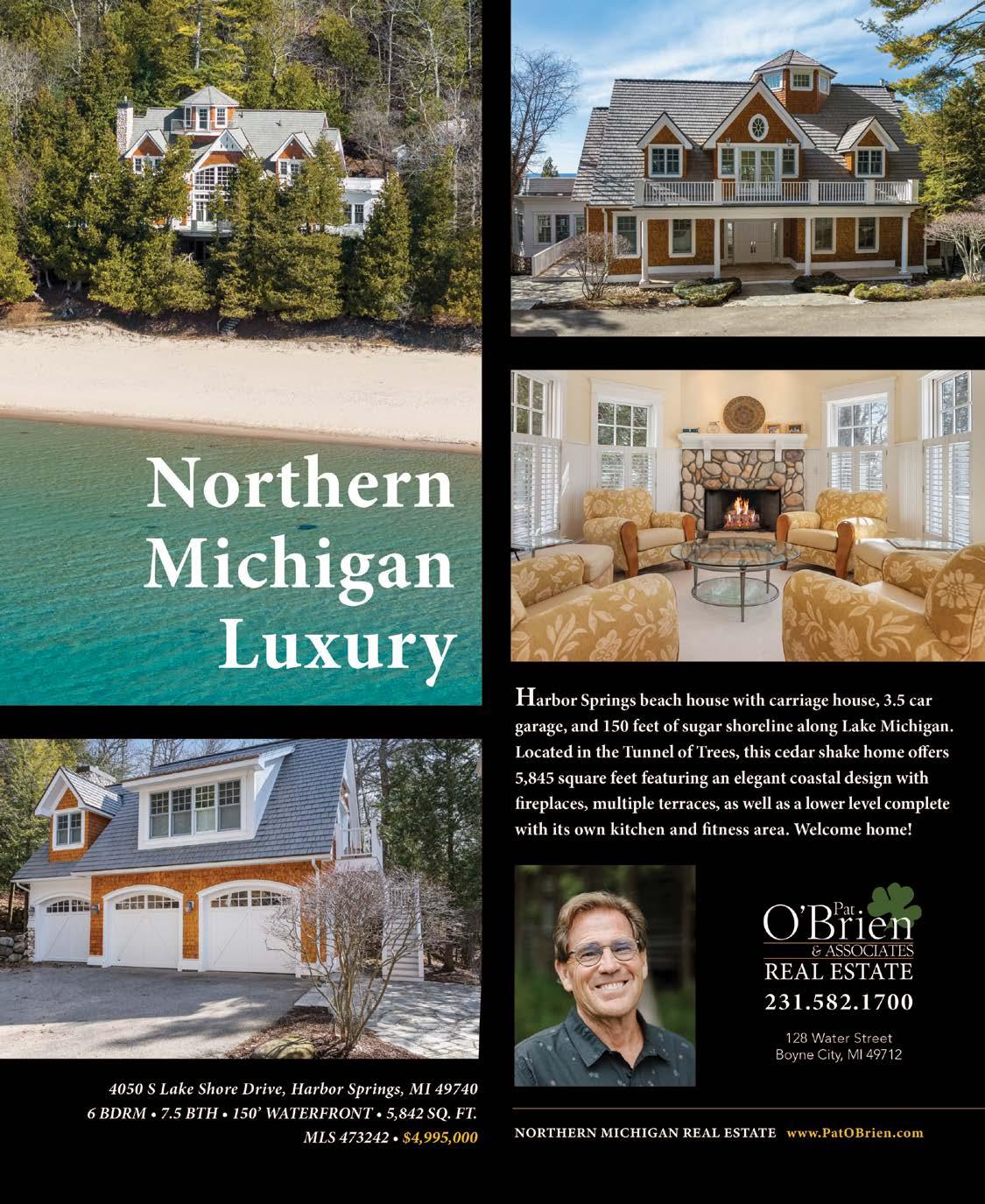
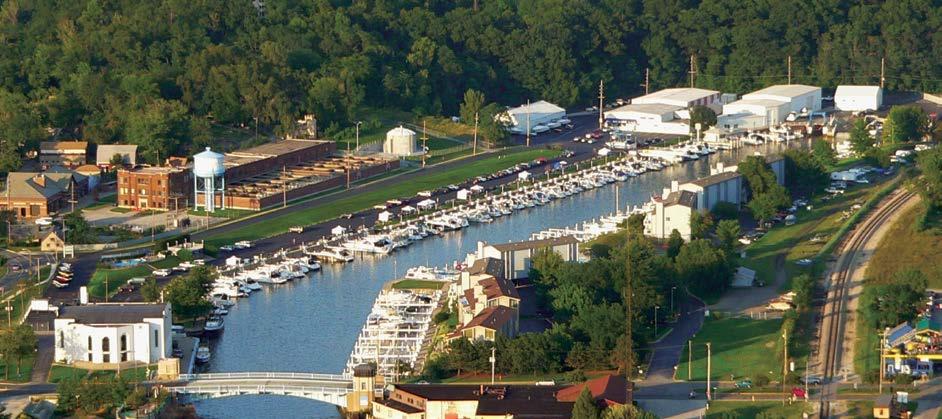
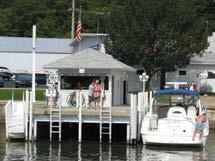
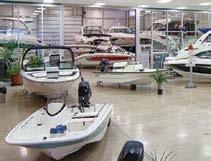
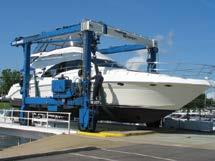
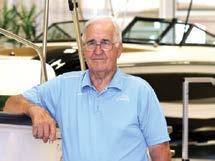
B&E MARINE
31 Lake Shore Dr. Michigan City, IN 46361
219-879-8301
BEMARINE.COM
AMENITIES
Transient Slips: Y
Pump-out: Y
Gas: Y
Diesel: Y
Lifts: Y
Launch Ramp: Y
Engine Repair: Y
Hull Repair: Y
Marine Store: Y
Restaurant: N
Showers: Y
Laundry Facility: Y
High-Speed Internet: Y
Pool: Y
A legacy of community, service and fun on the water!
ust 38 miles southeast of Chicago by water in Indiana’s Michigan City, B&E Marine has been helping visitors and locals alike have fun on the water since its inception in 1953. Started in a basement by Ron Bensz and Roland Evett, the company moved to its current location adjacent to Lake Michigan in 1954, leasing a parcel of land to erect a 560-square-foot building. In 1955, Bensz acquired Evett’s portion of the business, starting a strategy of growth and investment that would continue for years to come.
Today, B&E Marine occupies 10 buildings covering 100,000 square feet and employs more than 20 full-time employees. Its commitment to making a difference in people’s lives and community remains.
“Our father instilled in us the importance of giving back to our local community,” says son Rod Bensz, who along with his brother, Barry, purchased the business in 1987. “He was a visionary and had a major impact on the development of our lakefront,
fairgrounds, friendship botanical gardens, tower restoration, historical district, developing The Antique Market, etc.”
B&E Marine offers a full-service marina, boat repair, indoor and outdoor storage, a fuel dock, pump out, a marine store and a growing boat dealership that includes new, pre-owned and brokerage boat sales, along with financing.
B&E’s location is an ideal stopping point for boaters cruising between Chicago and Michigan, but Michigan City is a great destination in its own right, with a host of activities throughout the summer. Visiting boaters enjoy a host of community events, a long list of amenities, a Freedom Boat Club location, and a growing group of new boat brands for sale.
“What we do does make a difference in people’s lives; it brings families and friends together,” Rod says. “We are now serving third generations of our clients — it’s really pretty amazing!”















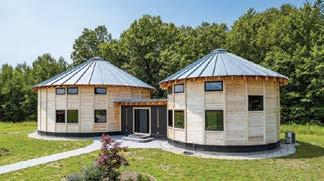





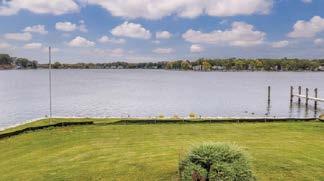












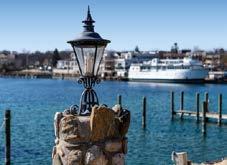
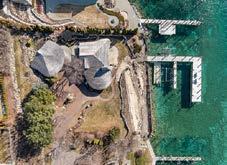
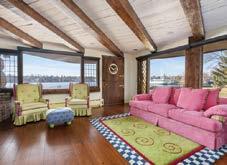
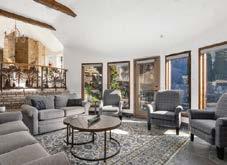







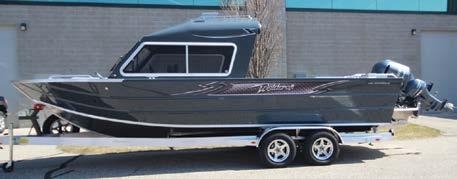

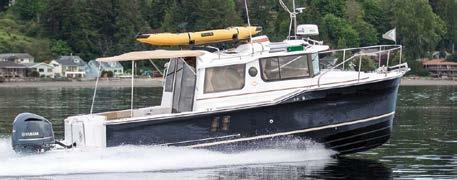
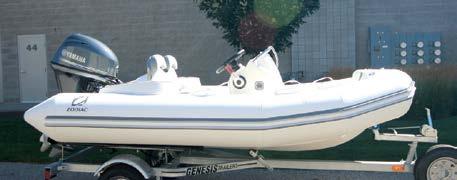
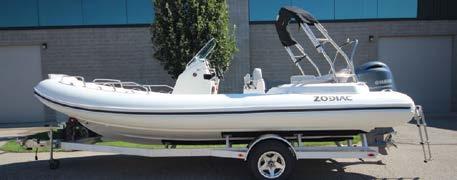




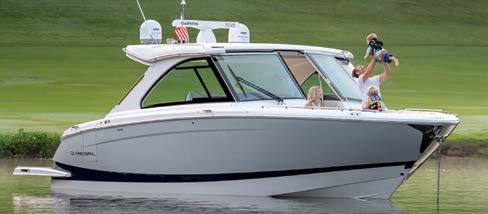

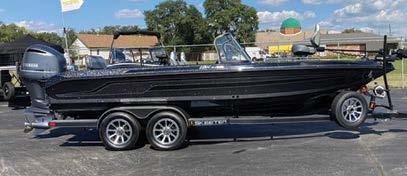


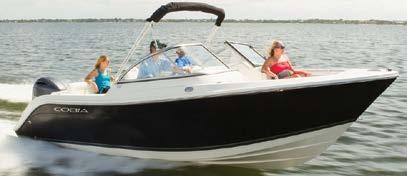
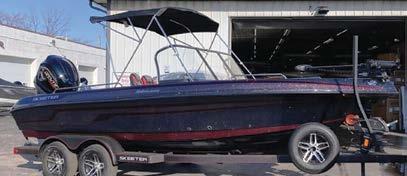
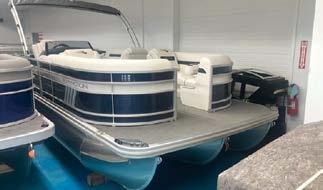
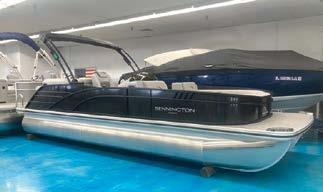

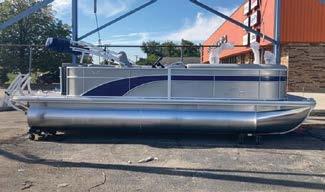
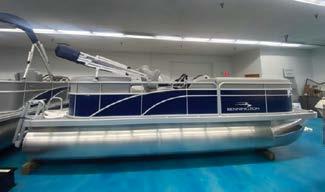

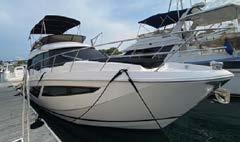
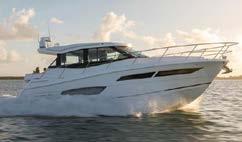

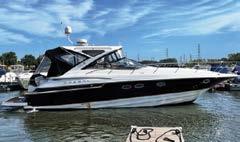
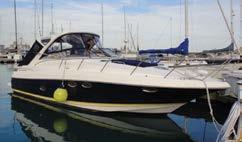
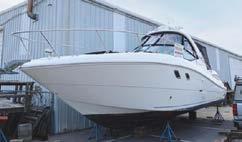
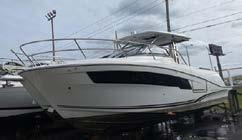
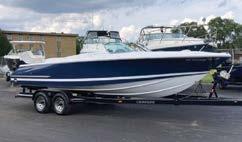
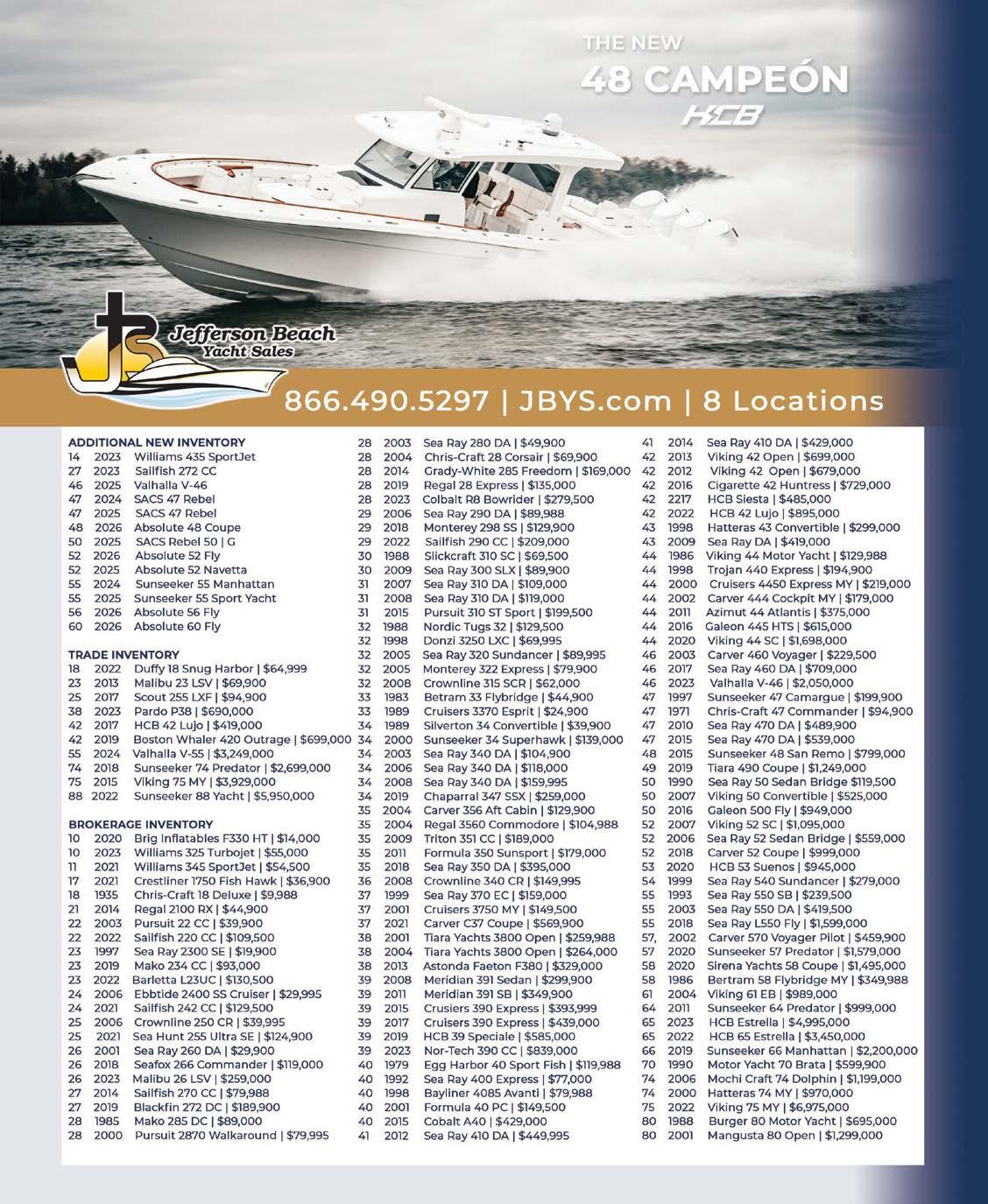

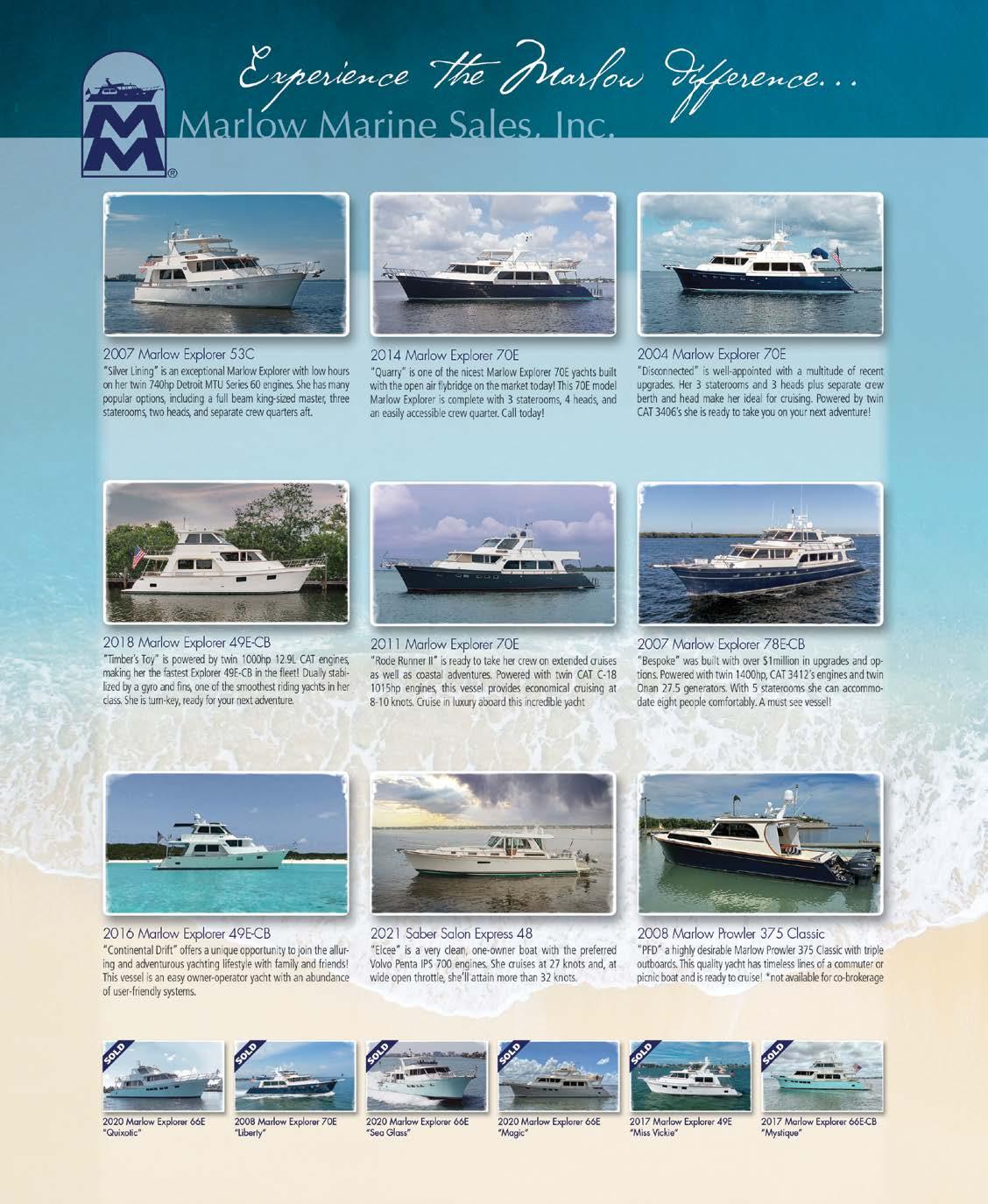
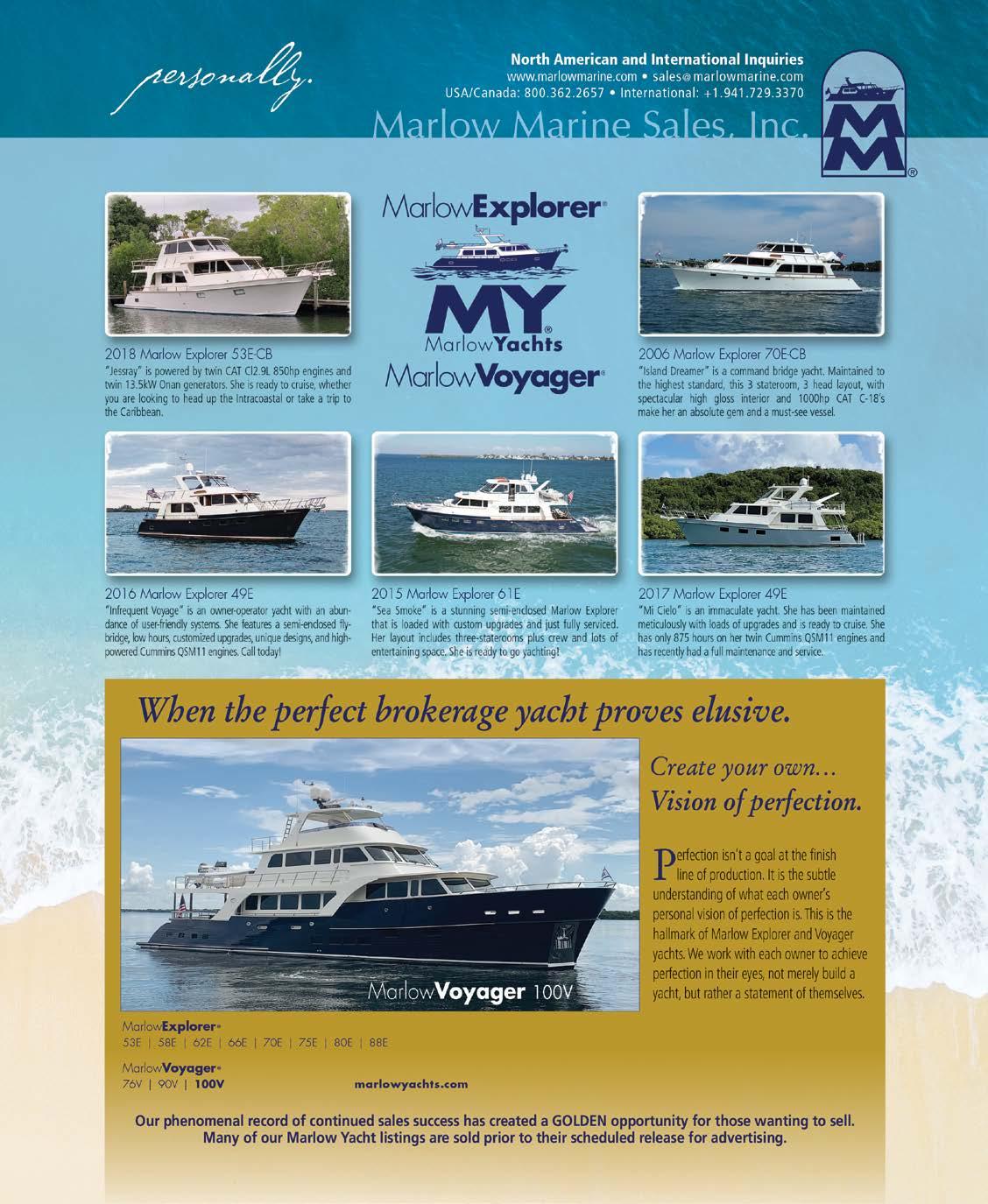
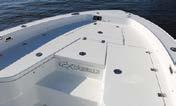
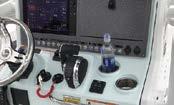

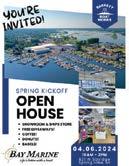
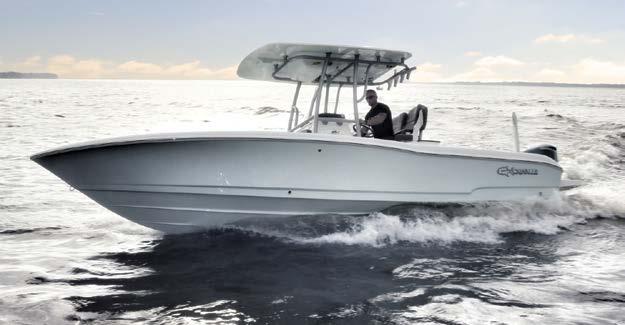
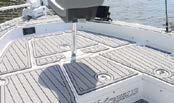
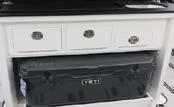

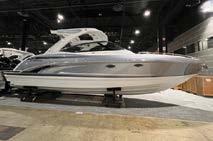



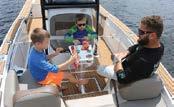


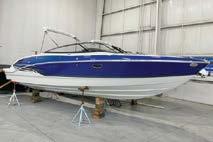
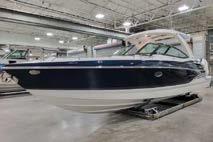

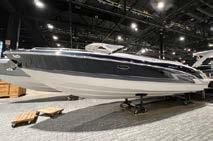
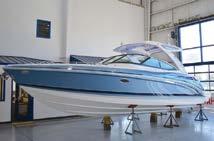
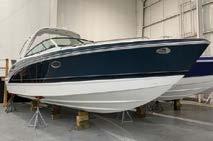
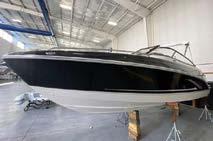



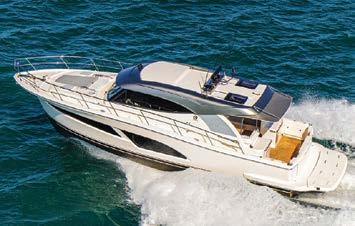
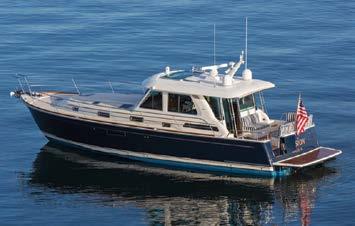


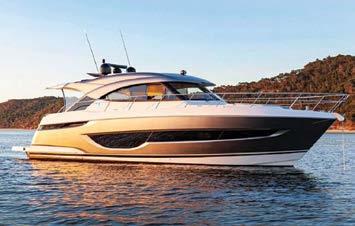


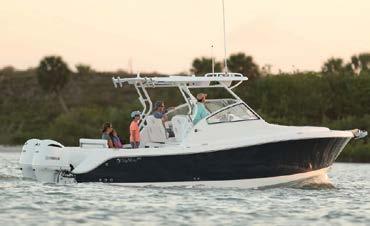
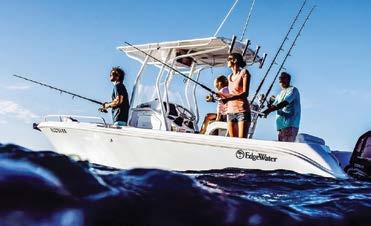

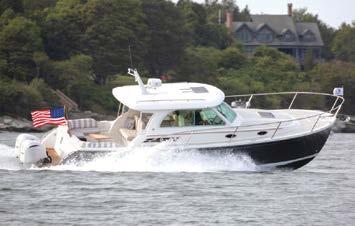
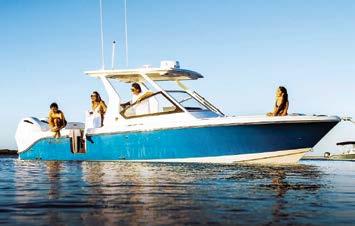
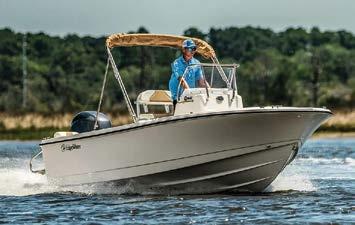
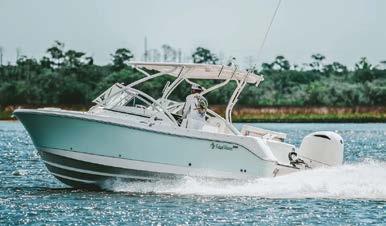
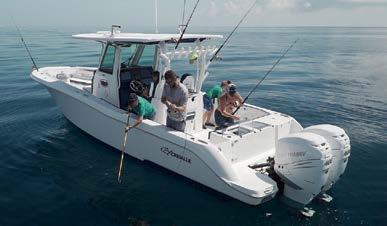
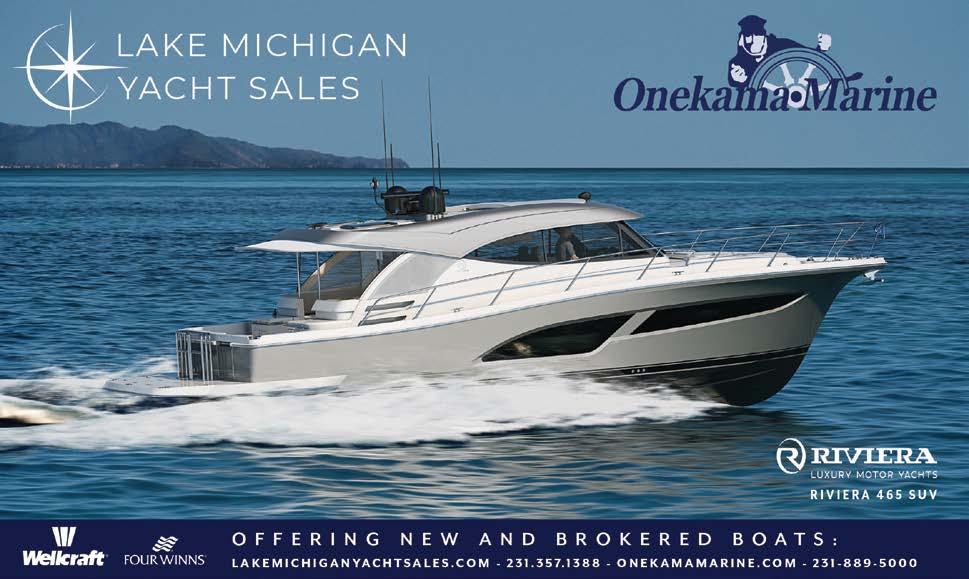




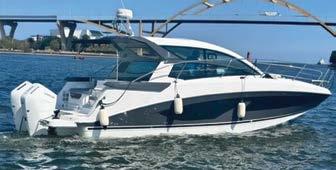

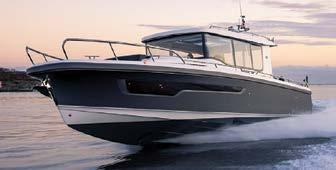

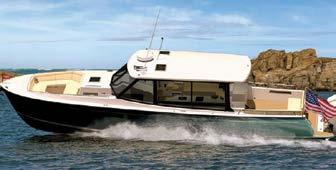




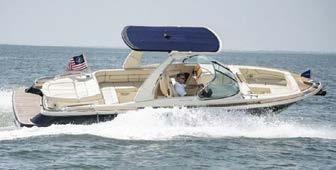

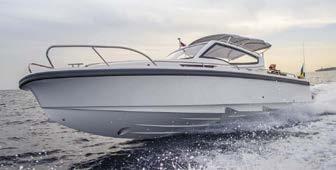







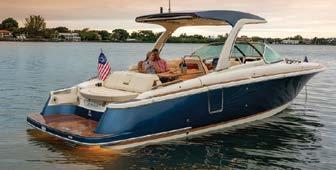

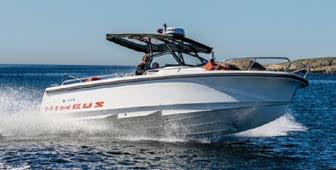

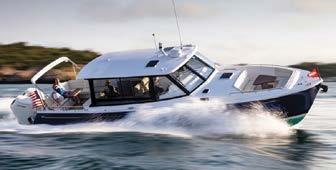

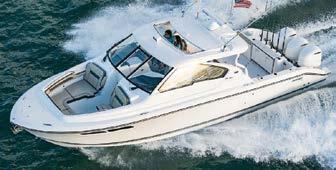








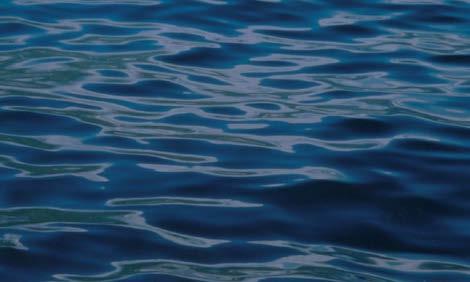


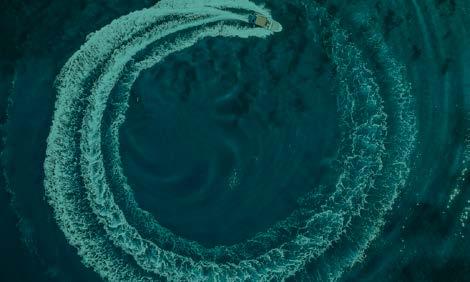



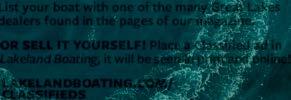

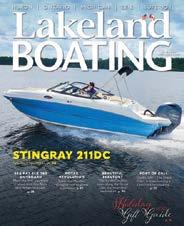





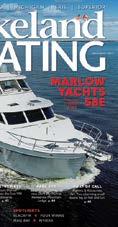
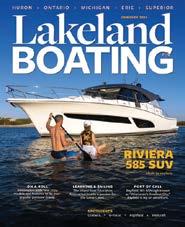
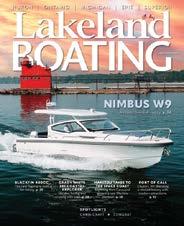






22' 2018 ZODIAC MEDLINE 660 Low hours and freshwater only! Excellent condition with Yamaha F175hp outboard on Aluminum Integrity bunk trailer. Custom all-welded T-Top with multi-color LED lighting. New 2023 Tubeset. Garmin color chartplotter/fishfinder/ depth. Ski pole. Cruise comfortably at 40 mph at 5000 RPM. Asking $65,000. Call Mark @ 414-651-3100 RYS

23' 2022 NORTHCOAST 230 CENTER CONSOLE
Almost new! Installed Jan. ’24: Garmin electronics package: GPSMAP 1243xsv (12" touchscreen); sounder with GT-23 TM transducer; and 215 VHF radio and antenna. Includes 2022 Integrity custom-welded bunk aluminum tandem axle 7,000 lb. trailer. 12-year transferable hull warranty, and 6-year Yamaha F250XB warranty. Asking $97,999. Call Matt @ 734-735-1948. RYS





2022 WELDCRAFT 240 OCEAN KING Freshwater and low hours! Full hardtop, single engine outback bracket w/ bottom sheet and swim platform. Extruded toe rail, selfbailing recessed diamond tread deck and 29" safety rails. Options include 120-gallon fuel tank, aerated livewell, anchor pulpit and more. Plus $40,000 worth of customs including Garmin touch displays, transducer, hydraulic autopilot, dome radar and more. Custom-welded aluminum trailer included. Asking $165,000. Call Mark @ 414-651-3100. RYS

25' 2022 JEANNEAU NC WEEKENDER 795 SERIES 2 Freshwater and many amenities! Only 155 hours on 200hp Yamaha engine. Heated storage. Garmin Echomap UHD Chartplotter/Sonar display Fusion Stereo, Dockside AC, bow thruster and new bottom epoxy barrier coat, plus VC17 anti-fouling paint in 2023. Includes twin-axle 7k lb. Venture trailer. Asking $129,900. Call Bob @ 616-843-1225. RYS
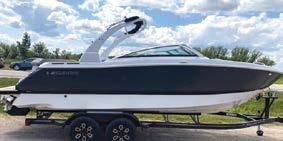
2023 FOUR WINNS H260 Check out this almost-new Four Winns H260. Gray with Mercruiser 6.2L 350hp, only 10 hours on the engine. Tandem axle custom trailer, floor storage, anchor locker, head with sink, depth finder, docking lights, ski/wakeboard tower with Bimini top, JL Audio System, lots of under-seat storage, stainless steel cleats, swim platform, and much more! Asking $105,989. Contact Info: tom@ centerpointesales.com or 414-232-2955. CNT
TO ADVERTISE IN CLASSIFIEDS Visit LAKELANDBOATING.COM/ CLASSIFIEDS for details and to submit your materials. Payments cannot be accepted online. We will contact you for payment once your ad proof is approved. Questions? Email Christy at CBAUHS@LAKELANDBOATING.COM.
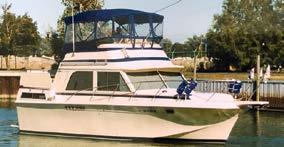
1987 CHRIS-CRAFT 362 T-270hp Crusaders, AC/ heat, generator, GPS/map, sum log, depth sounder, VHF, 2 staterooms, 2 heads/showers. Full Bimini enclosure, microwave, stove, refrigerator, boathouse kept. Asking $50,000. Call 419-366-4279. AUG24
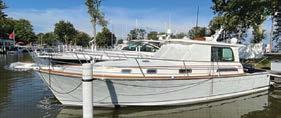

2010 40' SABRE SEDAN Twin 380hp Cummins w/ Zeus pod drives. 1278 original hours. 3 Zone AC/heat. 9KW Gen. Inverter. Windlass. Starboard side cabin door. Full electronics. All equipment working. Freshwater since 2017. Motivated seller. Price reduced to $435,000. Contact Ted at lakeandbay@roadrunner.com or 419-656-0408. JUN24

2023 RIVIERA 6000 PLATINUM EDITION Gyro, jet tender, Starlink. Details on boattrader.com. Moving to larger vessel. Find video tour and details on YouTube: BIT.LY/GRONORIV6000. Asking $2,499,000. Call Steve at 810-599-5147. APR24 REDUCED!



2022 PURSUIT S 288. Custom-ordered by her previous owners and tastefully upgraded. Equipped with joystick, autopilot, radar, hardtop-mounted rod holders and more! Her 200-hour service has just been completed and there are 2 years left on Yamaha warranty on the twin 300 Yamahas. This one will definitely not last long! Asking $289,000. Contact PJ Tamer for more information at pj@centerpointesales.com or 262-424-9627. CNT MALIBU WAKESETTER 23 LSV Single-owner, freshwater, in excellent condition. LOW HOURS (~170)! Lift-kept in season and heated storage off season. Malibu Monsoon M5Di motor and twin-axle custom Malibu trailer + spare, ready to tow to your favorite spot! Asking $107,900. Contact Joe today 414-793-0195 or joe@ centerpointeservice.com. CNT
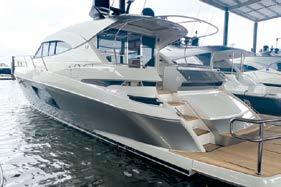



Our love affair with Pacemaker Motor Yachts began when friends of ours owned a 58-foot Pacemaker. As we traveled with them, shared dinners in their dining room, enjoyed coffee in the upper salon, stayed in one of their four guest staterooms and admired all the teak parquet flooring, we became smitten with this style and make of boat.
Then, one day, a 1979 66-foot Pacemaker Motor Yacht came on the market. The boat had been chartered in its earlier years. The gentleman we eventually purchased it from lived in Michigan and was a master woodworker who had begun to restore the boat. A chart cabinet and two end tables he made remain on the boat today.
When we took ownership, the boat was very dated. We were determined not to change the integrity of this beautiful boat as we became stewards at working to bring this boat back to its former glory. Year after year, she received updates to include new upholstery, drapes and curtains, new wallpaper and carpeting, refinished wood flooring and a wide-screen TV, to name a few. We love to cook and entertain, and have what we believe to be a small but state-of-the-art galley. Our dining room can accommodate up to six guests with additional seating of four at the dinette in the galley — an amenity you don’t see in boats of this size today.
She has been a labor of love and we feel she deserves to be called a Lady.
— Roy and Diane, Sturgeon Bay, WI

